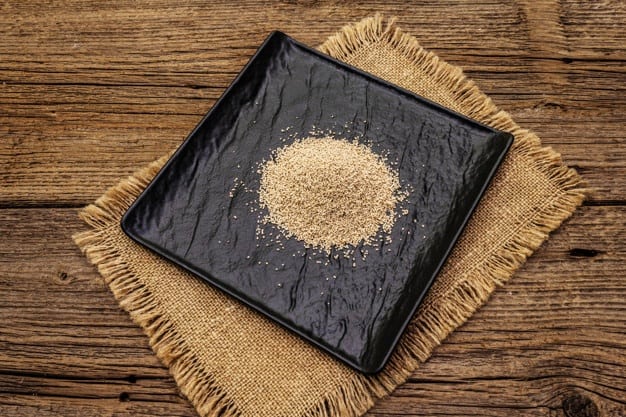The essence of Japanese cuisine is Hondashi. It is made of powdered bonito, which is intensified by MSG and other enhancers. How to use hondashi appropriately is a question to many people.
But if you’re not living next to a ready to enter Asian food shop, don’t have spare hours to keep a close eye on such a simmering pot, and if you’re only fresh to the menu, you probably have no supplies of freshly made dashi available.
Dashi is what a cube of broth is like in chicken broth. Though Dashi is delicate and restrained, the hondashi has become a cartoon painting with all of the hyper-expressive qualities enhanced. But all the chaos is also exactly what it takes to enliven a boring dish.
No products found.
I prefer to think it’s some kind of ingredient in my repertoire, handy when I have to apply meaty complexity to a meal or simply add flavor volume in every platter.
If you’ve ever questioned how to combine how to use hondashi in your culinary life. Here is the step by step for using Hondashi, everything you have to do is read this piece, which gives you all the details required to use hondashi. Me and our team are going to be your fellow-traveller, take you through these great info to know how to to use hondashi:
- Discover about Hondashi
- Difference of Dashi vs Hondashi vs Dashi No Moto
- Journey from Dashi to Hondashi
- Nutritional value of Hondashi
- Step by step, how to use hondashi for cooking
- Tricks
- Q&A Part
- Closing thought
Table of Contents
Discover About Hondashi
Hondashi – Mystery Of Cuisine
One of the largest stumbling blocks to meet home cooks as they want to diversify their food arsenal is not to buy the unfamiliar supplies they need—to learn how to make best use of them.
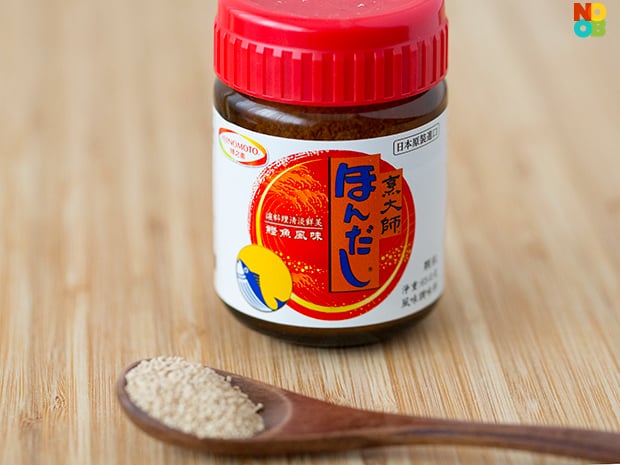
This is the factor why we continue to develop ideas about how those ingredients should be used. It’s not simply to help you guarantee that they don’t get waste once you have tested a particular dish, but also to give you a kind of general instruction on the benefits of having them around, when most of the pantry ingredients can also be used in numerous ways — see, for eg, our articles on all ways of using fish sauce or this article on soda flexibility. Then the same applies to hondashi.
Hon Dashi has become a fantastic example of such a flavoring product that few users use, or maybe even recognise. It’s about time that we updated it. Hon Granules Dashi is a flexible product that makes something you prepare healthier without separating the palette from its main flavors, whether it’s soup, stew or even risotto. Unless you’ve had miso that wonder what actually tastes so good, this is not miso, but really the dash of soup.
No products found.
Hon Dashi (initial flavor) is mostly made of Skipjack Tuna ( also called Bonito), salt, sugar and yeast extracts mixed. It’s an umami bomb powder that produces an intensely sweet liquid that can then be used to taste everything and anything. To say it briefly. All can create a beautiful, transparent stock of fish simply by applying Hon-Dashi pellets to warm water.
Hon Dashi has not only a salty flavor, but also a mildly sweet smoky and specifically smoky tone. And now you recognize how to use hondashi for your cooking. You can get it in almost every recipe that demands stock because the stock of Hon Dashi is not fishy. It doesn’t even taste fish, really.
The Purpose Of Hondashi Tastes So Frankie
In my humble view, Hon Dashi’s stock becomes superior to some other instant stock I’ve found. Why should Hon Dashi taste so good? I assume that’s because of the dual desiccation that eliminates all unpleasant smells in the manufacture.
I’m not an expert, but it’s about how it’s done: The Tuna will be first healed with salt for a long time before the bone is dry, rehydrated as well as cooked into water to create a bullion. The solids have been tensioned, while the solvent is frozen by an evaporator. It is then smashed into granules as well as the granules is then vacuumed into some kind of second dehydration in which the ice is directly sublimated to steam.
It really is lots more sophisticated in technology than producing cubes from your mill stock, when you thought about all of this, like reproducing the outside conditions. The complex procedure absorbs and kills the fishy smells that occur rapidly if the seafood is extracted, leaving an apparently mysterious natural sweetness.
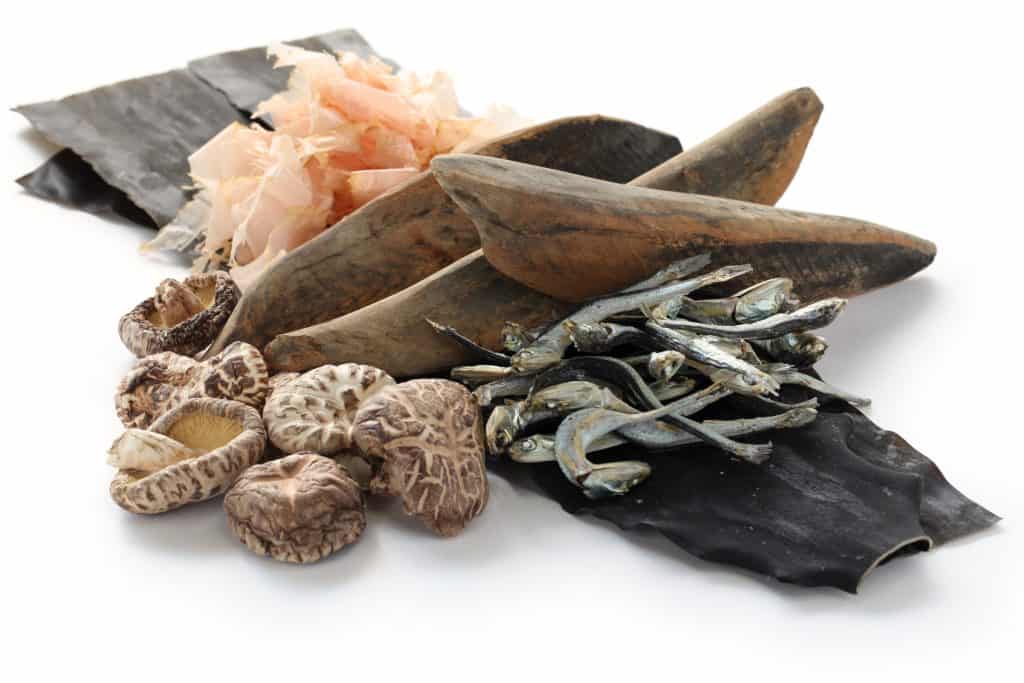
This variety includes celp, which many regard as the full dashi.
Hon Dashi melts to make a simple broth named Katsuo Dashi, that is excellent for cooking but seldom eaten directly. When it comes to Dashi that you drink like a drink, Awase Dashi, a second main ingredient is a dried kelp (called Konbu) that provides additional umami.
To get any of this typical Dashi consomme, you can pursue this connection to my Awase Dashi recipe. While HonDashi is available everywhere, it comes in a ‘Konbu’ shape, but it is less portable because you cannot create a bouillon even without kelp flavor then. Many Japanese housewives like to store traditional Hon Dashi granules in their own homes and add the konbu flavor whenever they want.
There are also a number of HonDashi, which are created by dried scallops (called Conpoy), rather than Tuna and here it should be mentioned.
This scallop variety has a shellfish flavor suitable for improving seafood dishes such as Bouillabaisse & Seafood Risotto. This diversity is also great for making soups in Chinese.
No products found.
If you have hooked yourself into a dashi instantly, you should still try utilizing fresh homemade dashi – but you may have an instant container on hand just for the case. It is not necessary to steep or strain—a teaspoon is quickly dissolved into a cup of hot water. You can go beyond soup to experience the real strength of instant dashi. I tend to think it is some kind of ingredient in my repertoire, handy when I have to add tasty complexity to a cuisine or simply add flavor volume in every platter.
If you are still confused about how to use hondashi. Try to add more HonDashi in your recipes if you’ve the chance for the variety of dishes. You can potentially be used even though no storage is required because it comes in granules rather than cubes. Try to sprinkle on salt instead. You will add this unique taste indication, though, which will leave the dinner guests wondering what your mystery ingredient is.
Difference Of Dashi Vs Hondashi Vs Dashi No Moto

If you prefer Japanese broth and also like cooking, so you’re obviously experimenting with dashi, and what about that umami enhancer, like hondashi & dashi no moto?
You actually find me here since you wondered just that! Let’s discuss all three varieties and that you can find out which one better suits your culinary desires.
Hondashi Vs Dashi No Motor Vs Dashi
Dashi, Hondashi & Dashi No Moto all seem to be recipe bases to give food the same flavor, but not quite the same. Dashi is basically a raw, hand-made dashi and most are that premade soup base of which the brand name Hondashi is an instant dashi commodity.
Hondashi
As described above, Hondashi isn’t so very well recognized as dashi, mostly because it’s not commonly available from outside Asia, but the name of a new product by Ajinomoto is a fully prepared powdered dashi.
It could however be used synonymously with dashi as well as is also used as a basis for miso as well as batter tempura.
This unique substance is often made from dried bonito flakes, many seaweed and some other flavors.
To improve its taste and scent, different kinds with Katsuobushi flakes may be added.
Each dashi variety has both a smooth & slightly sweet undercurrent which distinguishes it.
Dashi
If you don’t realize or you learned one a while ago, you might explain Dashi also as a soup base adding “Umami” to many Japanese dishes.
That cannot be used on by itself, as any other main, but instead is the base element from which to make the broth.
It’s also commonly used in the miso soup, but can be found in simple broth and broth soups such as my favorite noodles in various ramen.
It is often used to cook barbecues and is mostly combined into flour foundation to make dishes like takoyaki & okonomiyaki.
Usually dashi is provided by dried algae (Kombu, non Wakame), roasted bonito flakes (named katsuobushi), and/or salted sardines (Niboshi).
But there is still a liquid shape consisting of Kombu algae and a bright color soy sauce.
Dashi no moto
Dashi no moto seems to be an easy to cook fresh bonito flavor soup and is essentially a dashi. While Hondashi relates to the particular dashi product “Hondashi,” Dashi no moto relates to any dashi instant where No motorcycle stands for “base,” that is to say dashi soup base.
It simplifies and speeds the preparing with dashi and can work in a broad range of recipes.
It’s easily soluble in water, with the natural, rich, dried bonito umami taste.
Dashi Vs. Hondashi Vs. Dashi No Moto: Indispensable Taste
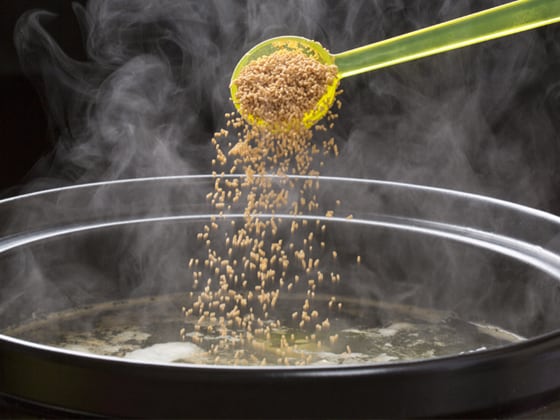
Dishes for Dashi
- Pan-Fried Tofu: Dashi becomes ideal to kick tofu. Add radish daikon to add more appeal.
- Dashi Furikake: This cuisine becomes commonly used in the steamed rice seasonings. It can also be made using the same katsuobushi and konbu you also use to make dashi. Alternatively, the remaining dashi may be used to offer your rice additional flavor.
- Handmade dashi stock: This soup dish is a traditional way of enjoying dashi and seems to be versatile enough for use in a number of dishes.
Recipes of how to use hondashi
- Nimono: Nimono has become a Japanese traditional dish of vegetables and chicken. The soup is cooked, and hondashi is the ideal basis for mixing including white wine, sugar and soy sauce.
- Fried rice: Hondashi provides an amazing rice topping. Apply soy sauce, mirin, just that little sake, and salt to help the taste come out.
- On Miso Soup: Combine hondashi into miso soup that brings up the taste.
Dishes for Dashi No Moto
- Dashi Shake Fries: This ingredient offers the best salt substitute for French friezes.
- Dashi Sour cream Vegetable Rolls: Combine dashi no motor with mayonnaise to give your raw vegetables a nice dip.
- Butter Steak: Mix dashi no butter motorcycle. Then let your steak melt to improve the flavour.
- However, you could use all these for each kind, but it is always best to make dishes with new, home-made dashi
Hondashi, Dashi Vs Dashi No Moto: Nutriment
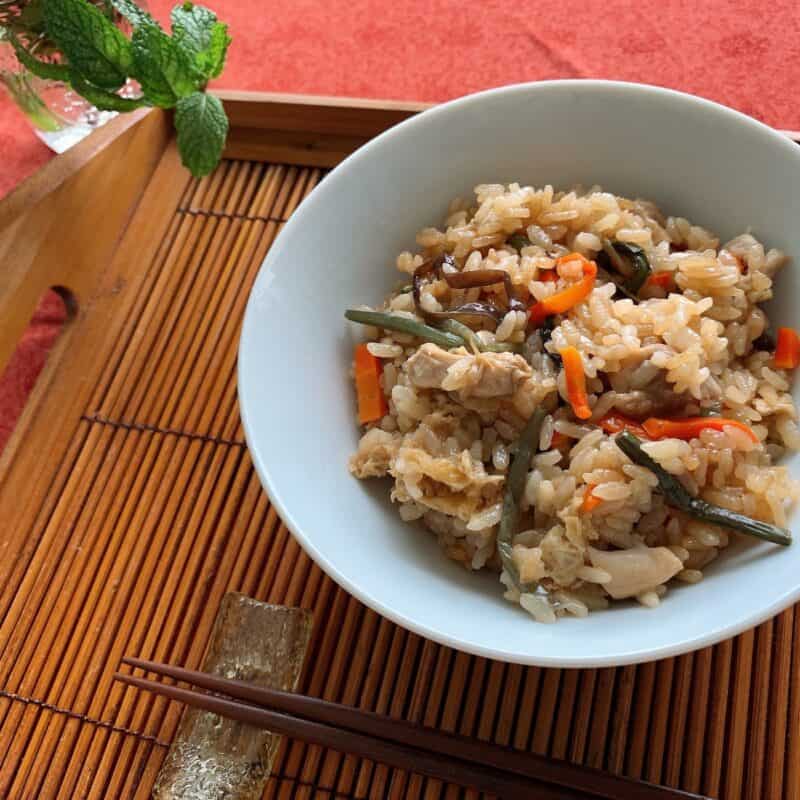
If these three ingredients are compared, dashi no moto can be the simplest and most flexible in the recipe but are no longer nutritionally available.
Homemade dashi has been created with naturally occurring materials.
Dashi no moto is processed, on the other hand. It can also include MSGs that many claims are not safe.
People claim it is associated with tumors, headaches as well as other health problems. This was never statistically confirmed, however.
It also should be pointed out that every dashi not branded as dashi but marketed as an instant dashi is just a refined food commodity and should not be considered dashi no moto.
Dashi vs. Hondashi vs. Dashi No Moto: Extra information
Though it can sound like pain for making dashi, rather than buying hondash, it is not so difficult to blend the batch yourself.
It needs only a few basic ingredients and generally it takes 10 minutes to make them.
If you enjoy the rich flavor of Japanese broth, hondashi, dashi and dashi no moto, all of this will give you the taste you seek.
Journey From Dashi To Hondashi
It’s no mystery that umami tastes delicious to Japanese cuisine. In 1908, when the word was coined in kombu dashi, it represents a fifth flavour, previously salty, soft, sour and bitter, named actually through Professor Kikunae Ikeda including its Tokyo Imperial University.
Dashi is a good basis for miso broth, ramen, spicy Japanese pots with sauces. Dashi is often used in Japanese cuisine any time liquid is needed in a recipe. Overall, this is an unbelievably flexible broth which is used to give umami flavours, and is especially popular for vegan cooking as a broth.
Not to consider, dashi offers multiple health advantages, like other broths, because of its ingredients. Kombu, the brown seaweed, has high concentrations of iodines, phosphate, copper, phosphorus, magnesium, zinc, including B, C, D, and E vitamins. It also gives the broth amino acids, which aid us heal from muscle injury. Dried bonito flakes also demonstrated a reduction in blood pressure, improved circulation and even increased cognition.
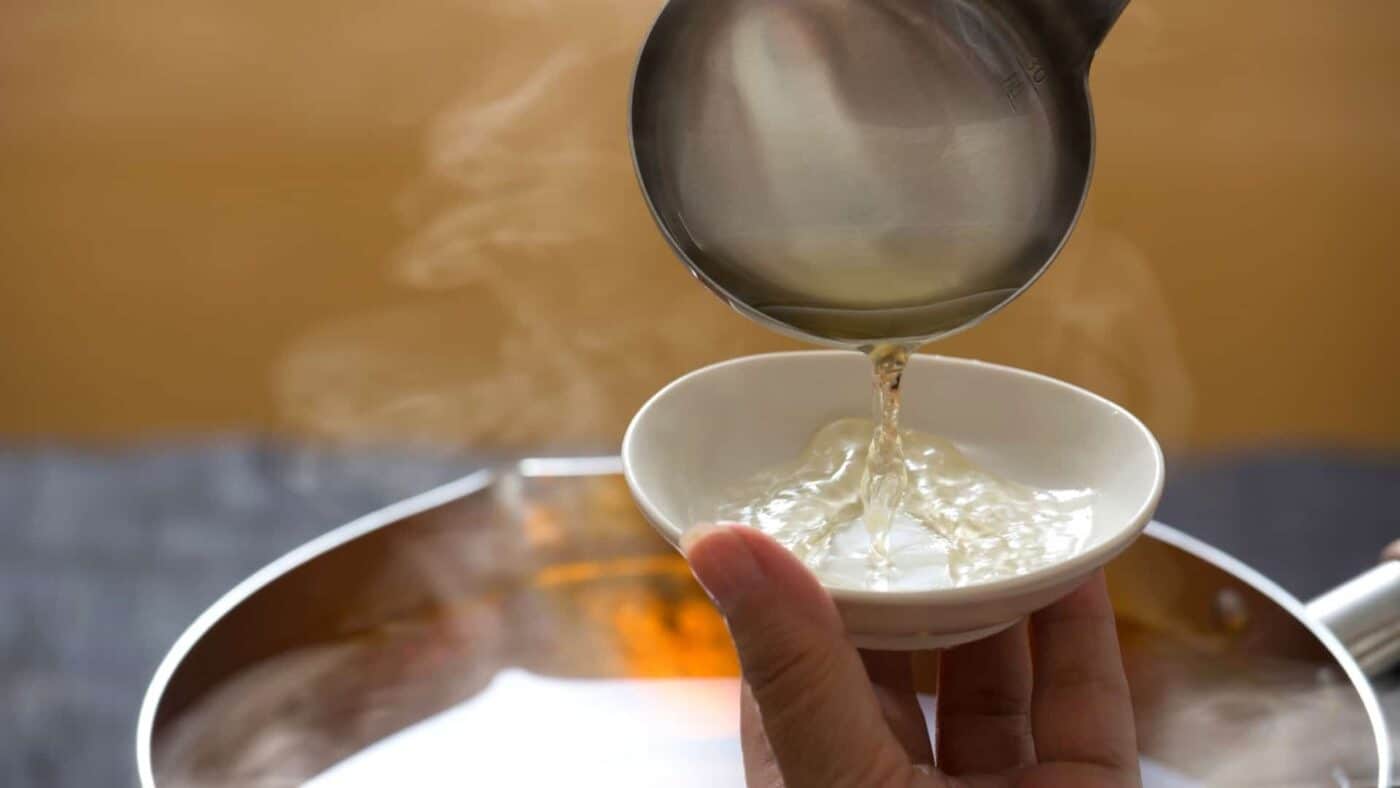
Dashi is really the key component of several of the finest foods. The broth with a rich taste consists of steep kombu, a dried celp style and katsuobushi, dried or even aged tuna. When mixed with water, both two turn into a savory lip sweet foundation, from miso to a gently steamed custard. Though Dashi is comparatively simple compared to other shimmered broths & stocks, it’s a quicker shortcut to flavored broth, which is HonDashi.
To dashi, Hondashi is a chicken broth bouillon cube. Though Dashi is delicate and restrained, the hondashi seems to be a cartoon painting with all the hyper-expressive features enhanced. But all the chaos is also exactly what it takes to enliven a boring dish. It is made of powdered bonito, that is amplified with MSG as well as other enhancers.
There’s no steeping nor straining necessary — a teaspoon can quickly dissolve it into a cup of water — but you need to go beyond soup to understand the full strength of hondashi. I generally think it is some kind of ingredient in my collection, handy when I have to add tasty complexity to a dish or simply add flavor volume in every platter.
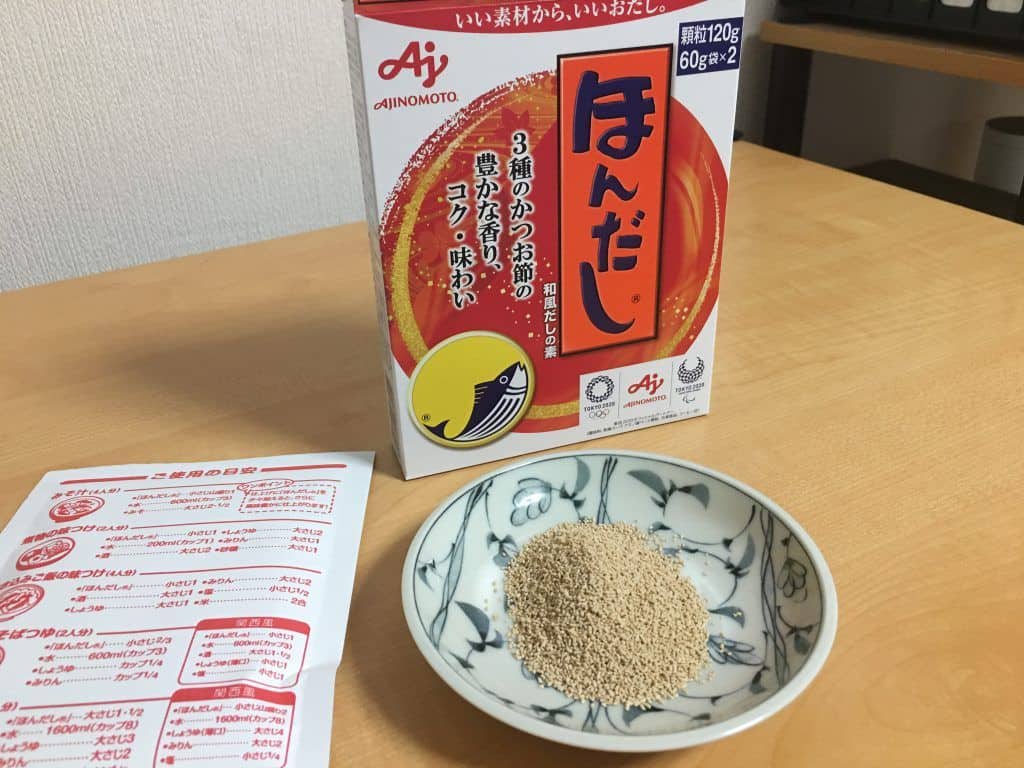
The hondashi I always hit is made by the Company in Japan Ajinomoto, whose creator, Kikunae Ikeda, created it in his wife’s dashi to recreate a savory taste. The Hon Dashi is available on Asian or online markets.
Nutritional Value Of Hondashi
Hondashi can be used for all children and adults. And especially it is even more suitable for children. The nutritional values that Hondashi brings:
Essential nutrients for your baby: Japanese Hondashi contains Dextrin which is a starch breakdown agent, which aids in digestion and absorption of nutrients effectively for babies.
Hondashi provides enough protein and energy necessary for the development of children when entering the weaning period.
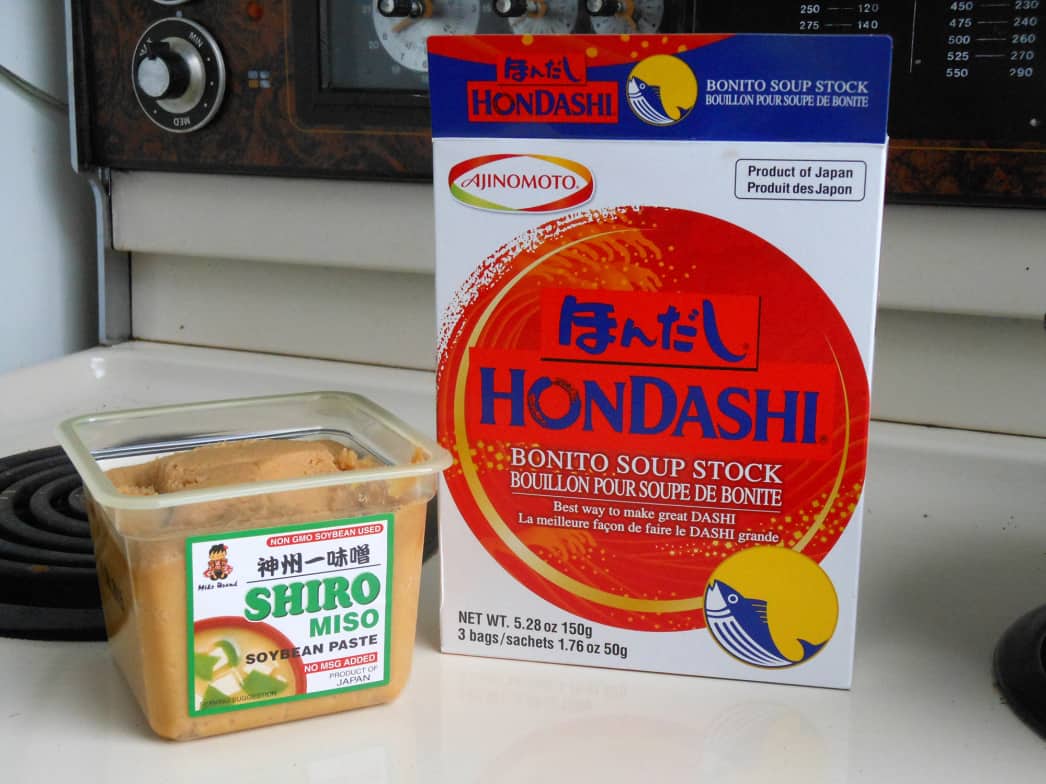
Products made from cooked tuna and seaweed and fine crystalline powder are convenient to enhance nutrition and diversity for the child’s snack menu: cooking porridge, flour, soup, soup …
Easy to use which is convenient for storing and preserving for repeated use. You can save time without the security of Kombu algae and Katsuo flakes.
Rich in fiber content to help reduce blood cholesterol, support weight loss, promote the functioning of a good digestive system, prevent intestinal cancer and limit constipation.
Supplement vitamins and minerals for intellectual growth, physical enhancement, height development, support strong bones, promote collagen regeneration for bright, smooth skin, prevent wrinkles, help nails and hair is strong and shiny.
Step By Step, How To Use Hondashi For Cooking
How to make standard Japanese food with hondashi will become much easier if you have the right tools. Making this dish yourself at home will save you a lot of money compared to enjoying it outside the restaurant. One of the reasons why this delicious dish is so expensive is that it is so laborious to produce. In addition, the dishes require fresh and high quality ingredients. In it, fish is one of the most popular ingredients of this Japanese dish. To make this delicious dish with new and more creative recipes, please refer to the following article immediately.
- Dashimaki Tamago
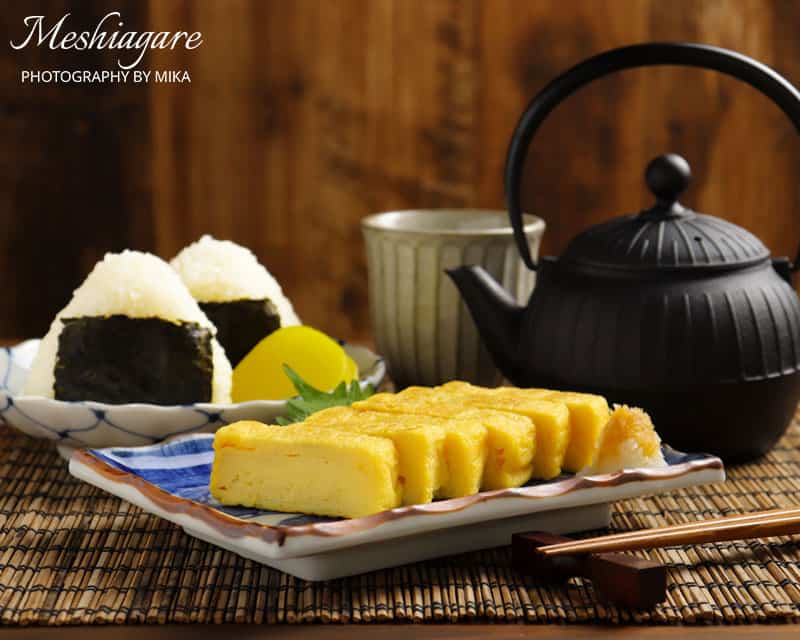
No products found.
This Japanese-style fried egg dish is one of the traditional dishes in cherry country. In addition, it is not difficult to make this egg, but you need a rectangular pan, a specialized type to make DashiMaki Tamago and a sushi roll, and some other familiar ingredients. is enough. Very interesting way, please refer to below.
Material:
3 chicken eggs size L
4 tablespoon Hondashi
2 teaspoons of sugar
2 teaspoons of sake
Making:
1. Mix sake, sugar and hondashi to dissolve well.
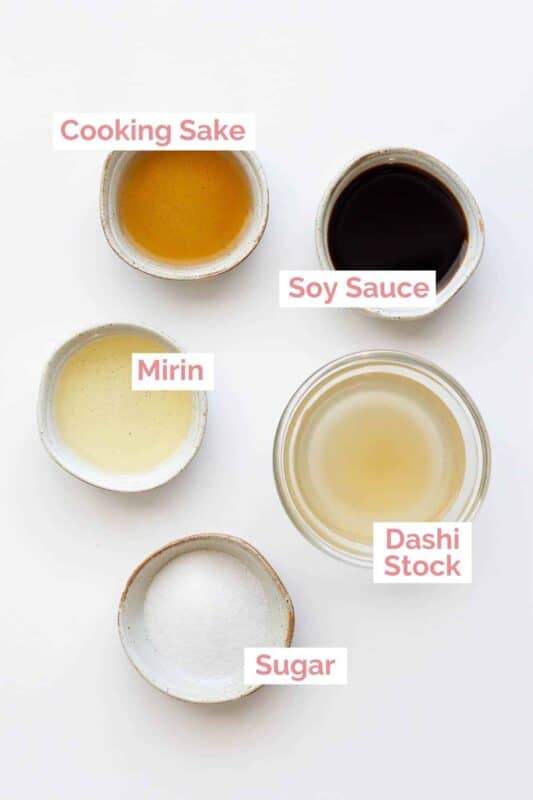
No products found.
2. Beat eggs to dissolve evenly, remember to stir with a large ring to dissolve evenly before then stir well the un-melted parts such as egg whites for a smooth, even mixture.
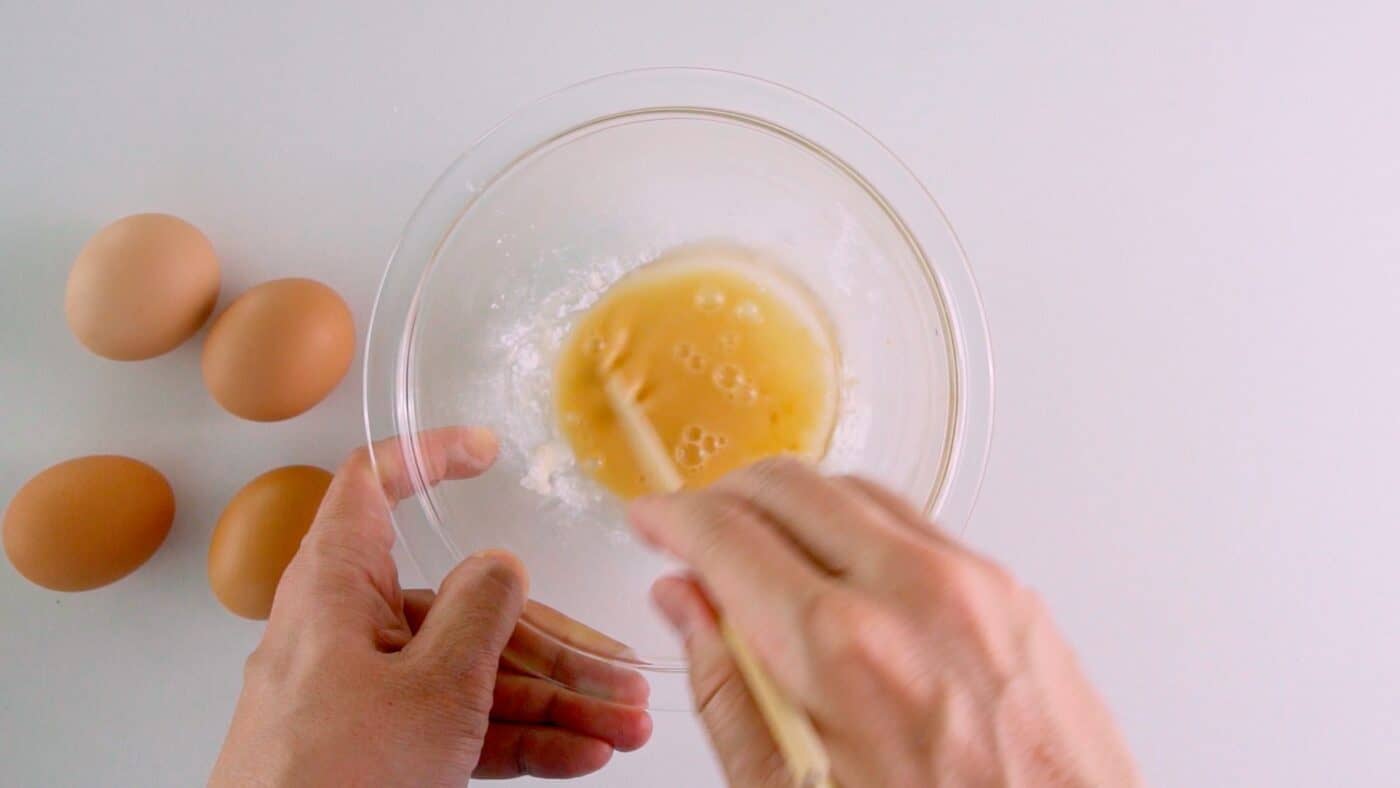
3. Next, mix mixture 1 into egg mixture and stir to dissolve well.

4. Prepare the best skillets for glass top stoves, the specialized type to coat Dashimaki Tamago, put the skillet on the stove to heat, then use a towel to soak the pan so that the pan is covered with 1 layer of smooth and thin oil.
No products found.
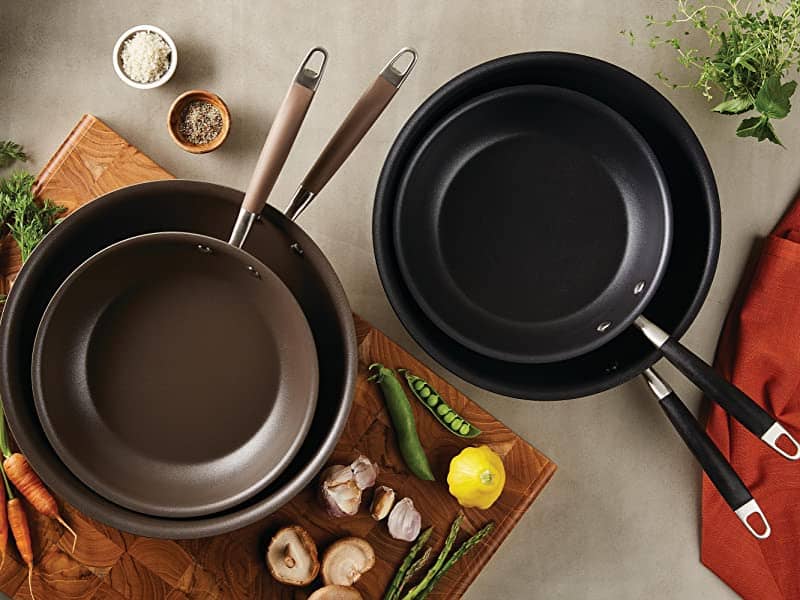
5. Then, put a few drops of eggs on the pan if the eggs are ripe, then it’s ok, then pour 1/2 part of the egg mixture into the pan, then use the chopsticks to gently stir the egg surface to make the eggs cook evenly.
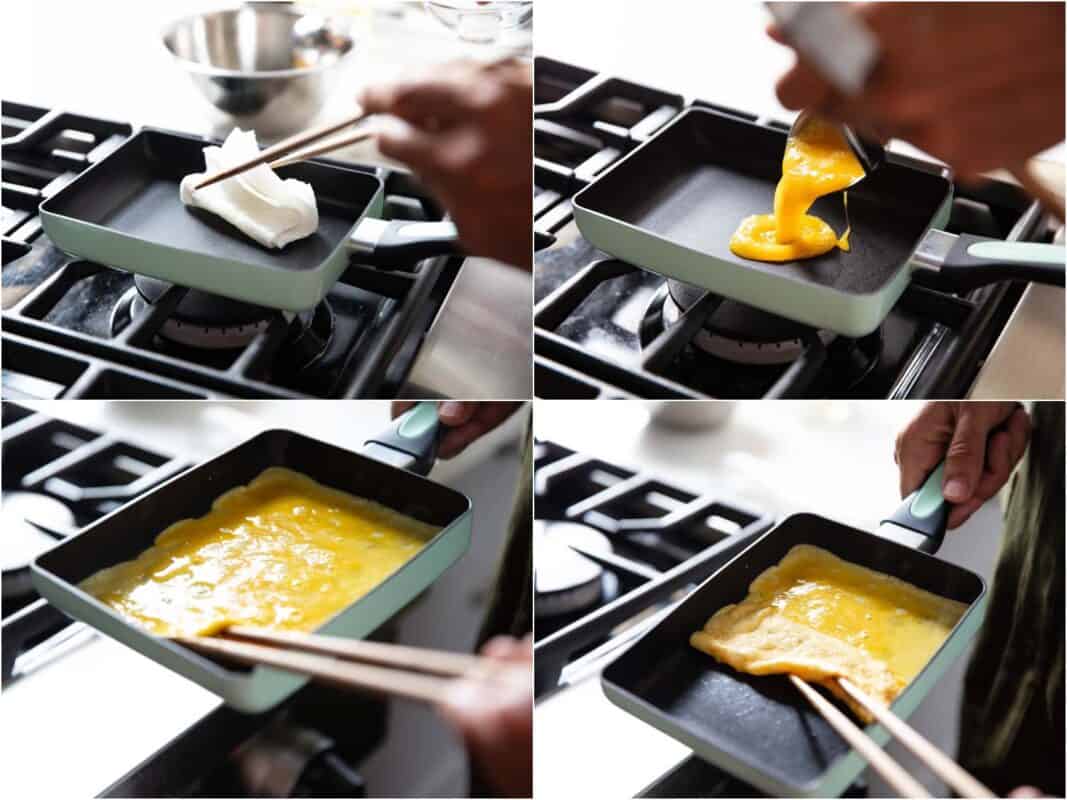
6. When the surface of the egg is about 1/2 cooked, roll the eggs like a curl when rolling the sushi mat from the top down, then gently push the egg up on the pan, then continue to absorb more oil on the pan. coated another thin egg layer on the pan.

Use the chopsticks to lift the egg roll from the top to let the eggs flow evenly throughout the pan, then use the chopsticks to stir gently, then when the eggs are about 1/2 cooked, then continue to roll the eggs from the top down.
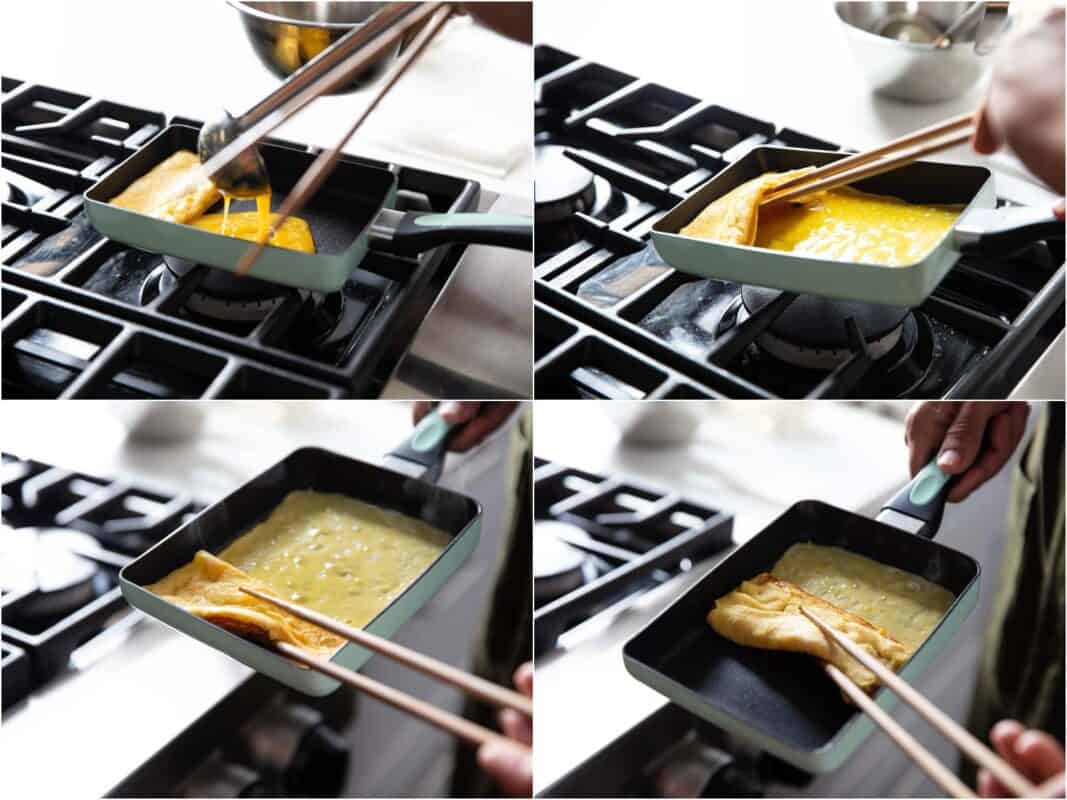
7. The egg has been rolled, then we put in bamboo sushi rolls to roll the eggs, leave for 10 minutes to make the eggs curl shape sturdy and beautiful.
No products found.
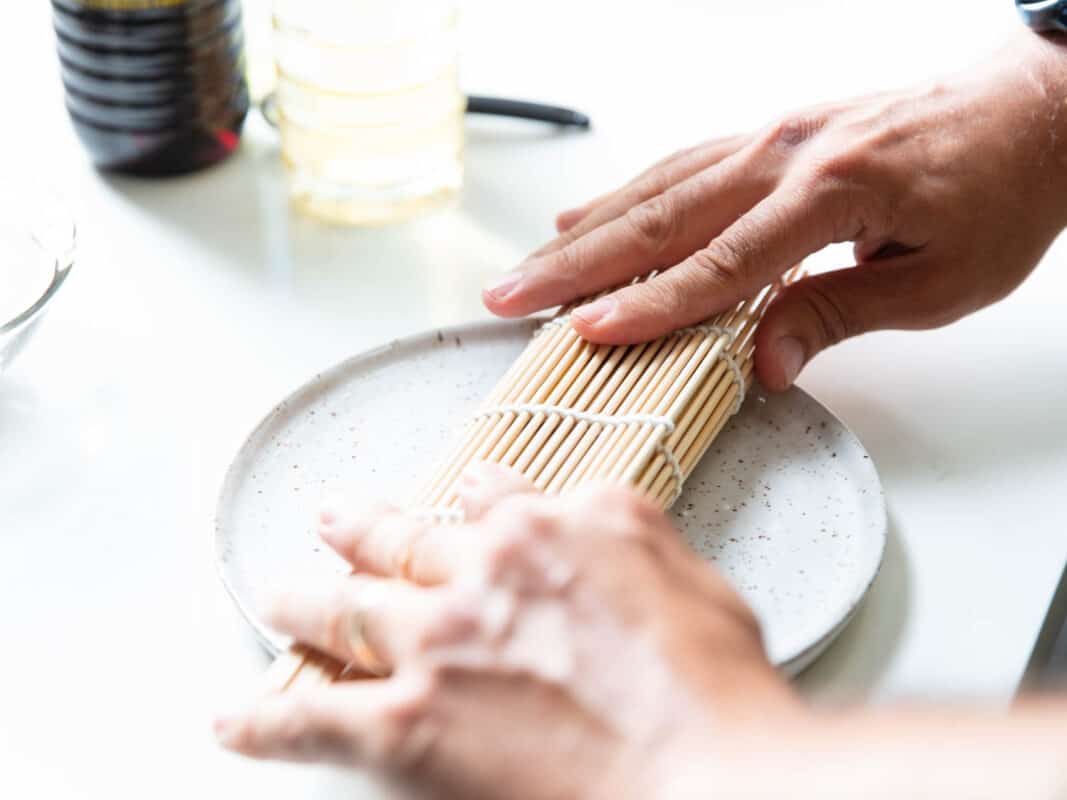
- Salmon sushi with shrimp eggs
Material:
1 cup of sticky rice
5 tablespoon Hondashi
200 grams of salmon fillet (washed, sliced long)
4 pieces of dried seaweed
100 grams of shrimp eggs
1 tbsp rice vinegar
1 fresh avocado (peeled, remove the seeds inside, cut the avocado into long strands like the photo)
Half a teaspoon of table salt
Making:
- Preliminary processing of salmon, avocado, shrimp eggs to make sushi
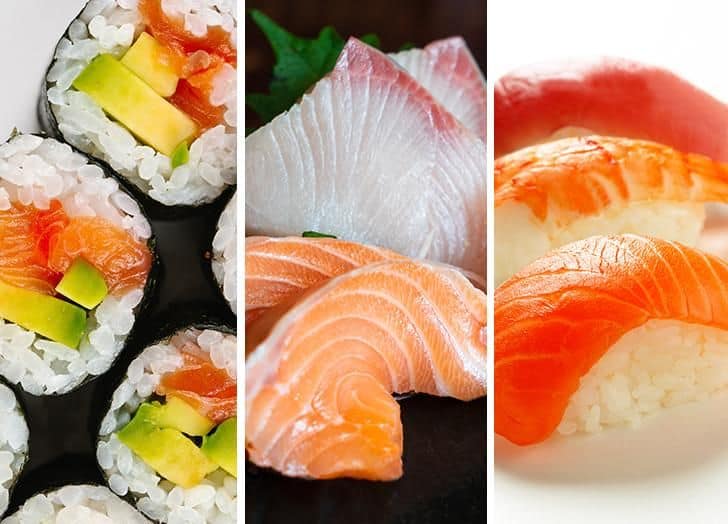
- Step to prepare salmon, avocado, shrimp eggs to make sushi.
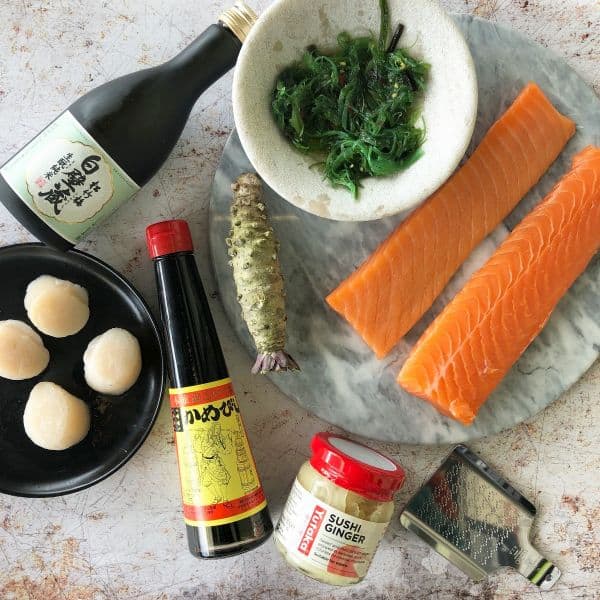
- Place the rice bowl in a large bowl or bowl.
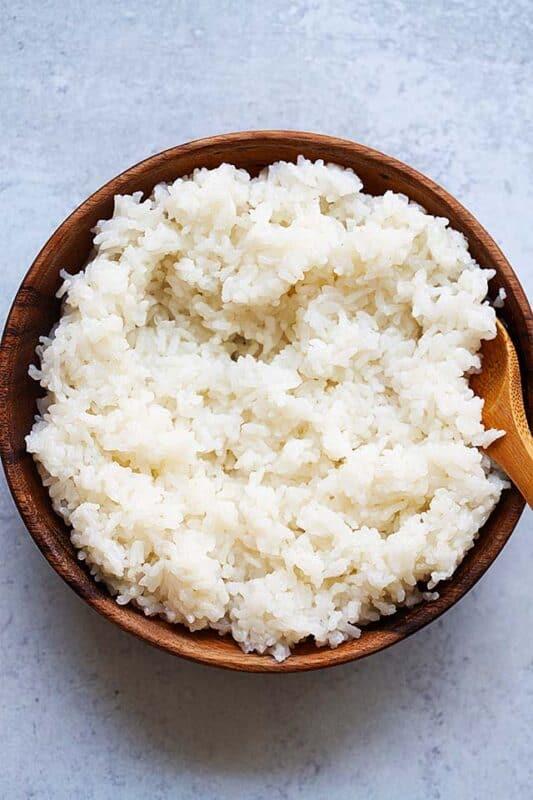
- Add vinegar, salt and hondashi to the rice bowl, mix well.
No products found.
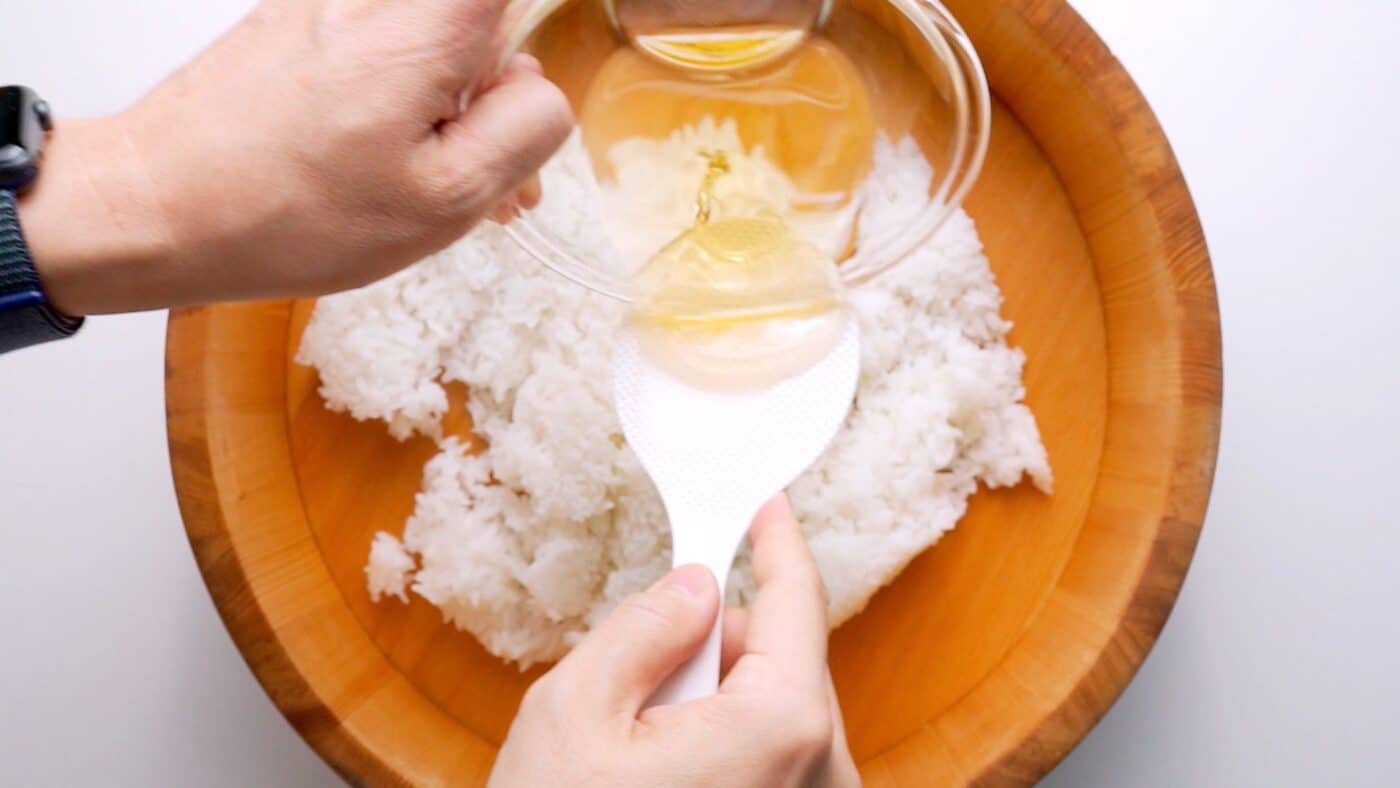
- Pour vinegar to mix with sushi rice to remove the smell of raw seafood.
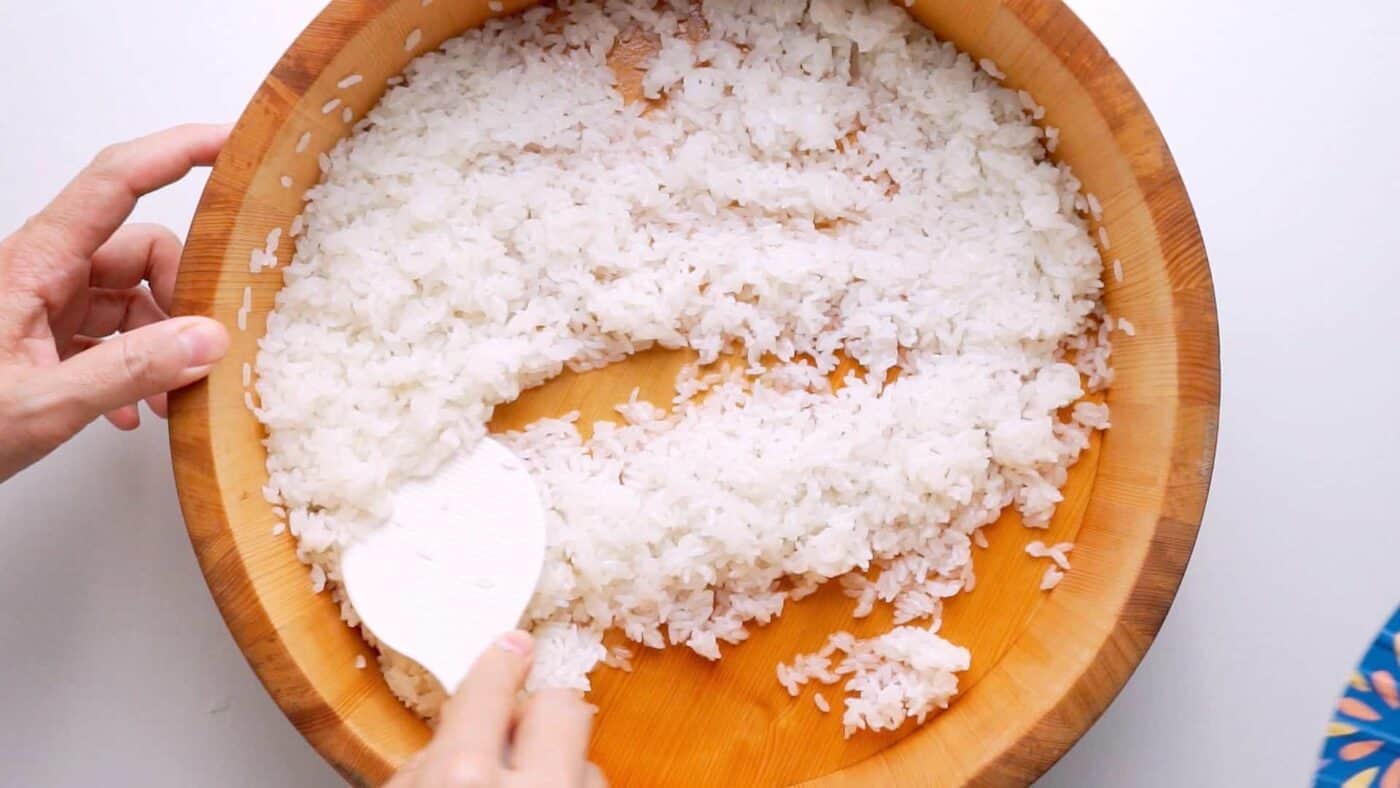
- Set aside the rice, prepare the sushi roll. Rice mixed with vinegar has a sticky texture and tastes better.
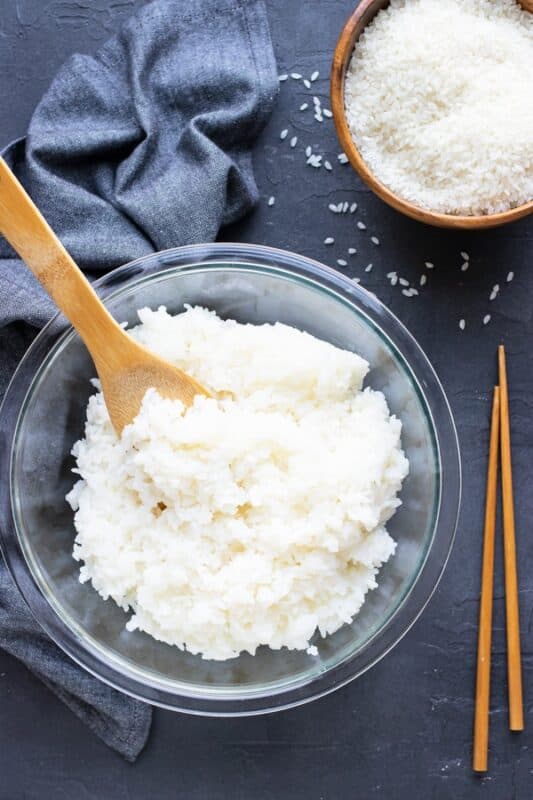
- Spread a piece of seaweed on the screen, spread a thin layer of rice on top.
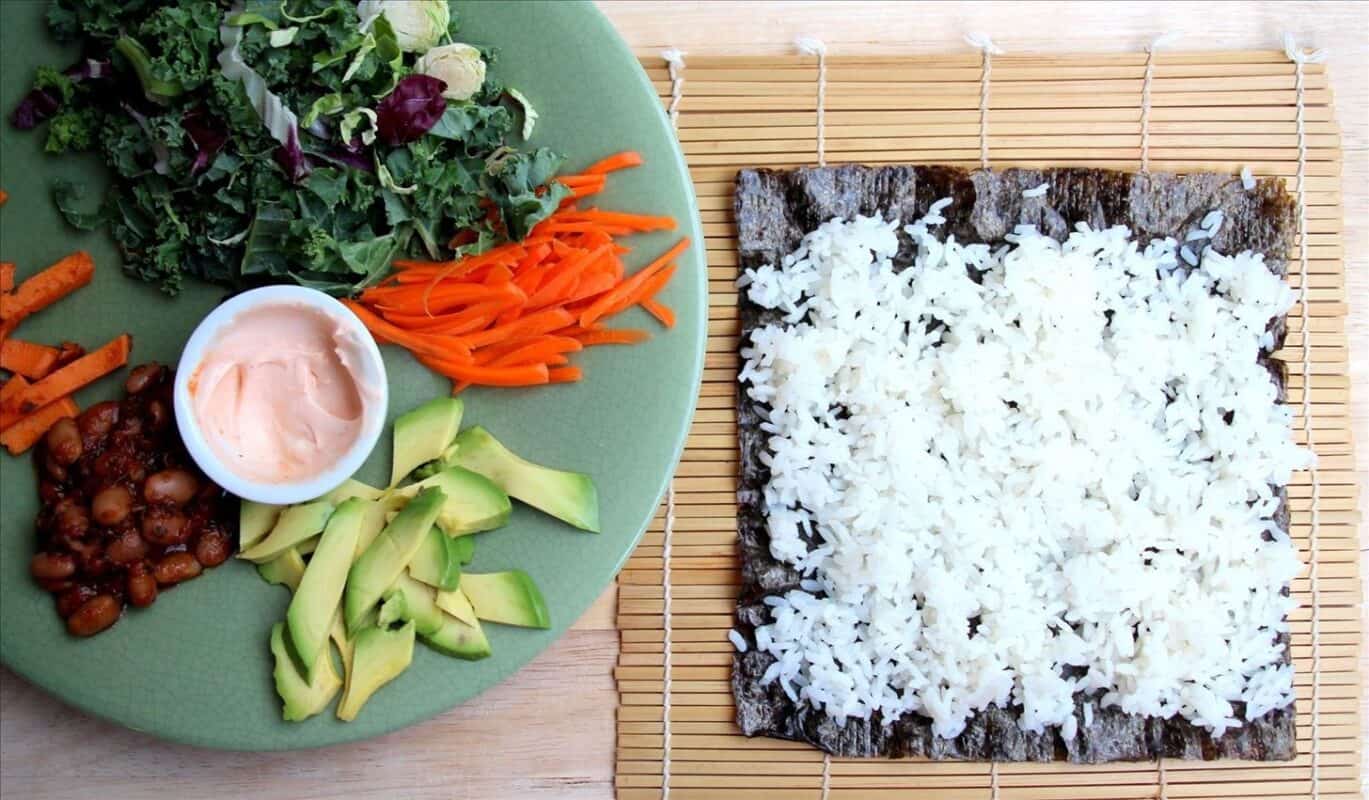
- Take the shrimp eggs, spread a long layer across the bamboo blinds, and put the rest of the ingredients on.
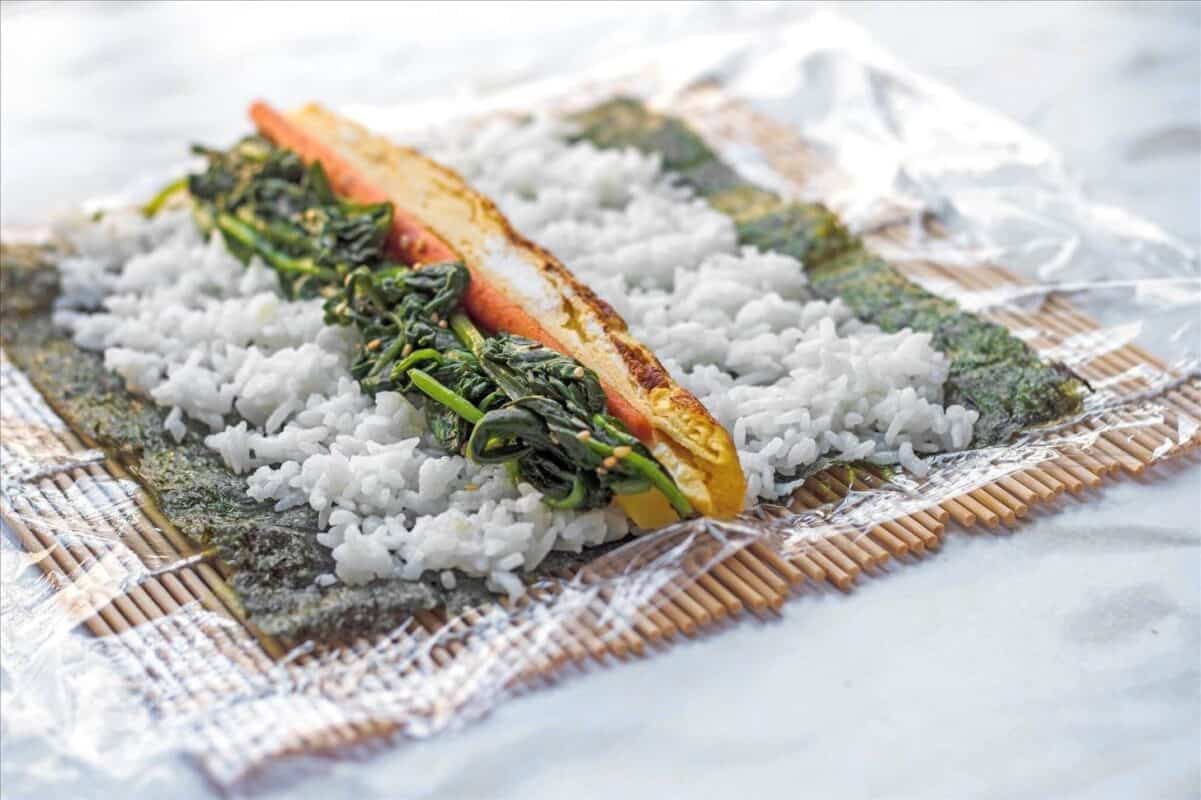
- Roll your hands tightly in circular motions until the piece of seaweed is gone.
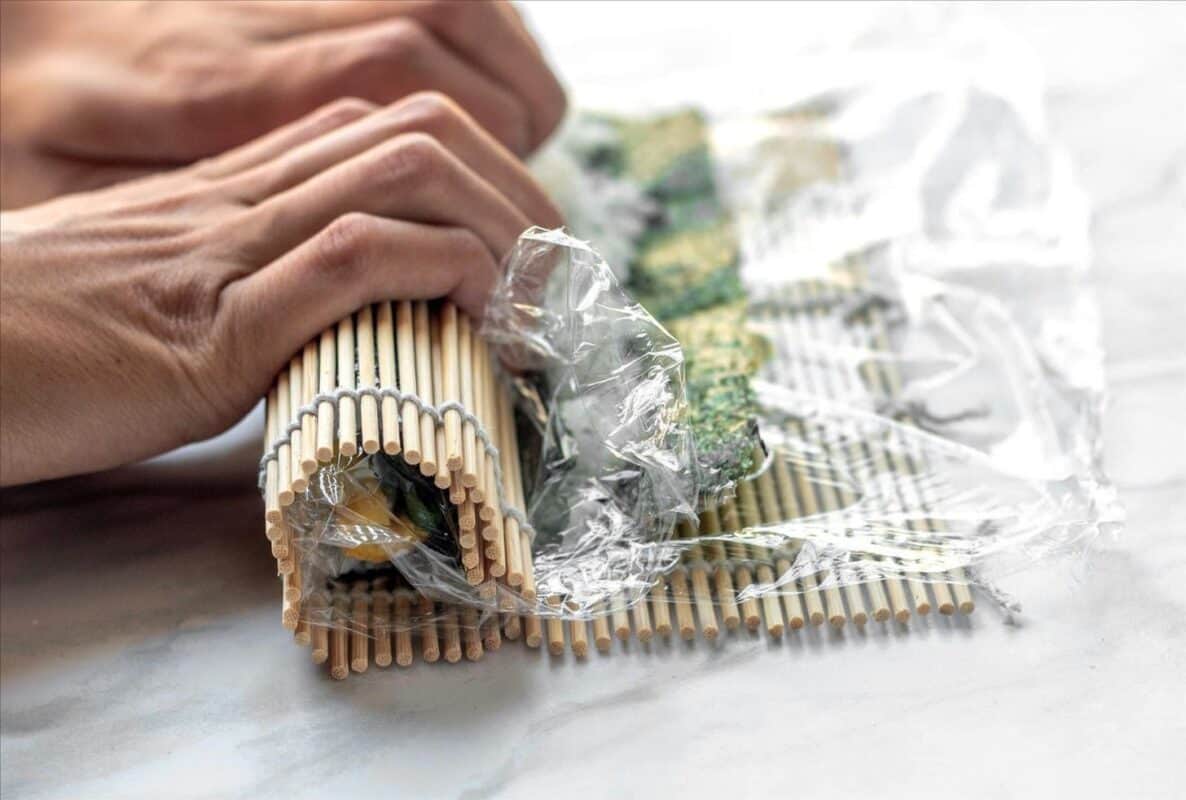
- Cut sushi into circles, you can sprinkle it with a little shrimp eggs, dipping with sauce to enjoy.
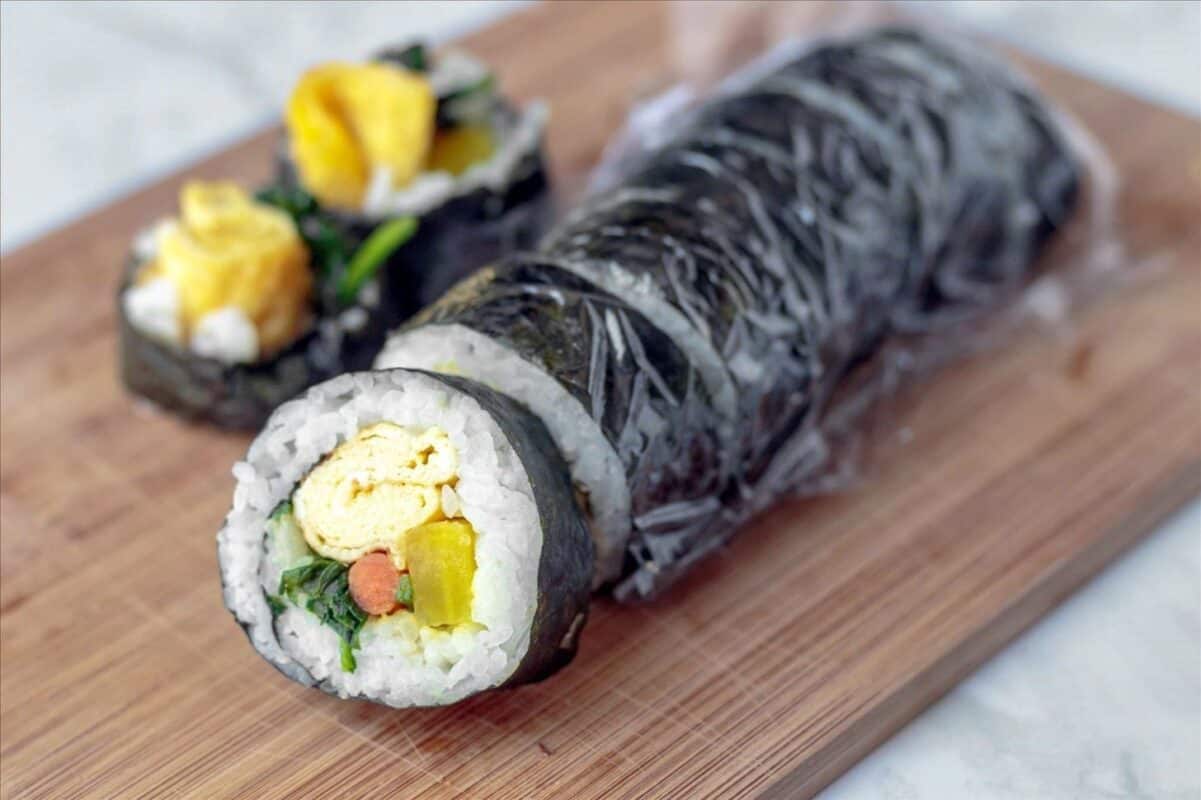
- Fry sashimi sushi
Material
You want to change the taste of your everyday sushi by deep frying without the need for deep fried flour? Then try the recipe below.
Cooked rice mixed with sugar vinegar: 150 grams
1 piece of dried seaweed
3 tablespoon Hondashi
4 – 5 sticks of asparagus washed
1 slice salmon fillet
Crispy fried dough plate
A little bread crumbs on another plate
Tools: bamboo blinds.
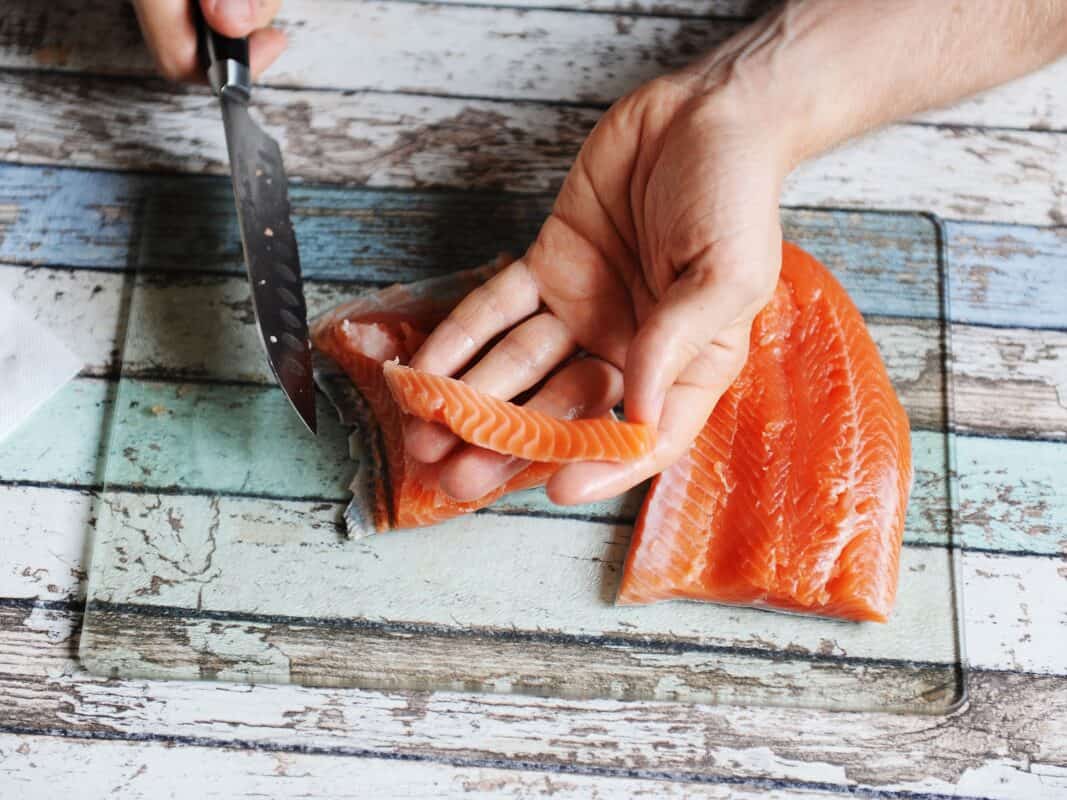
- Spread a thin layer of sushi rice over the bamboo blinds, evenly spread, about 3 cm from the top edge of the curtain.
- Place the seaweed layer on top of the rice.
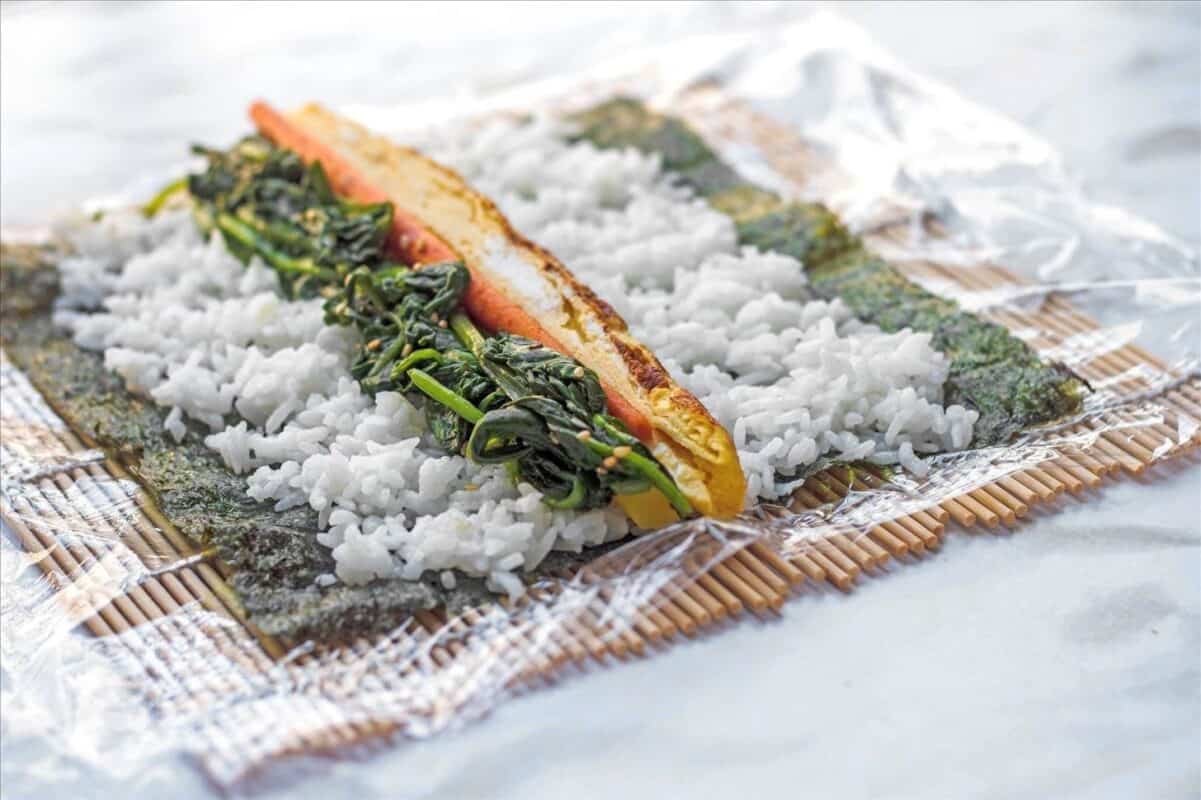
- Arrange the asparagus sticks the width of the seaweed piece, less than 1 cm from the edge.
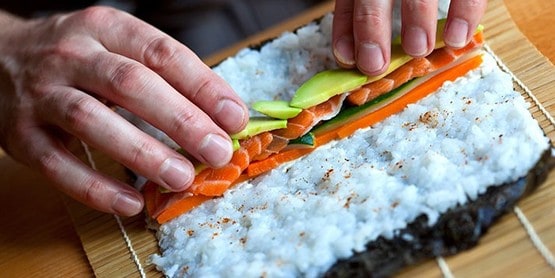
- Place the salmon sashimi fillet on top of the asparagus.
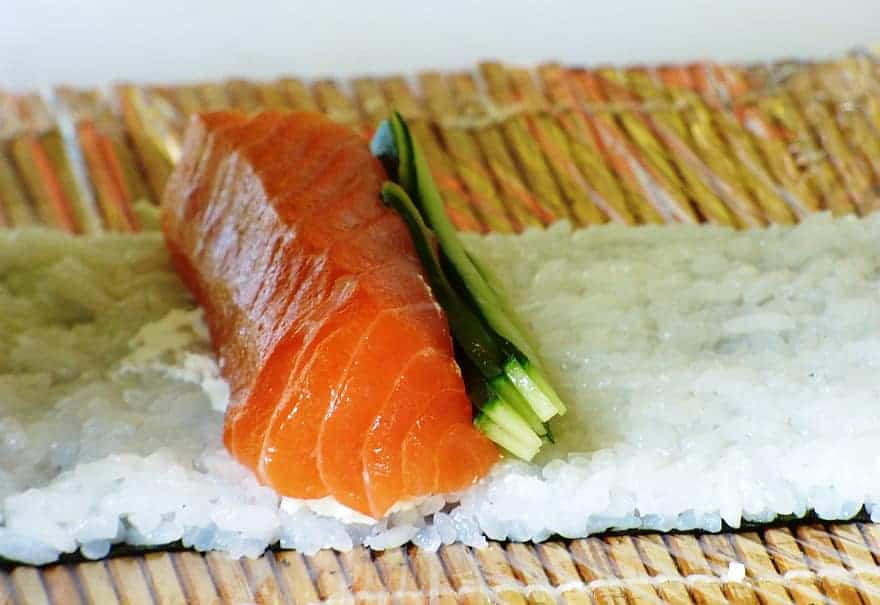
- Start using your fingers to roll the sushi together, press firmly to wrap the ingredients together.
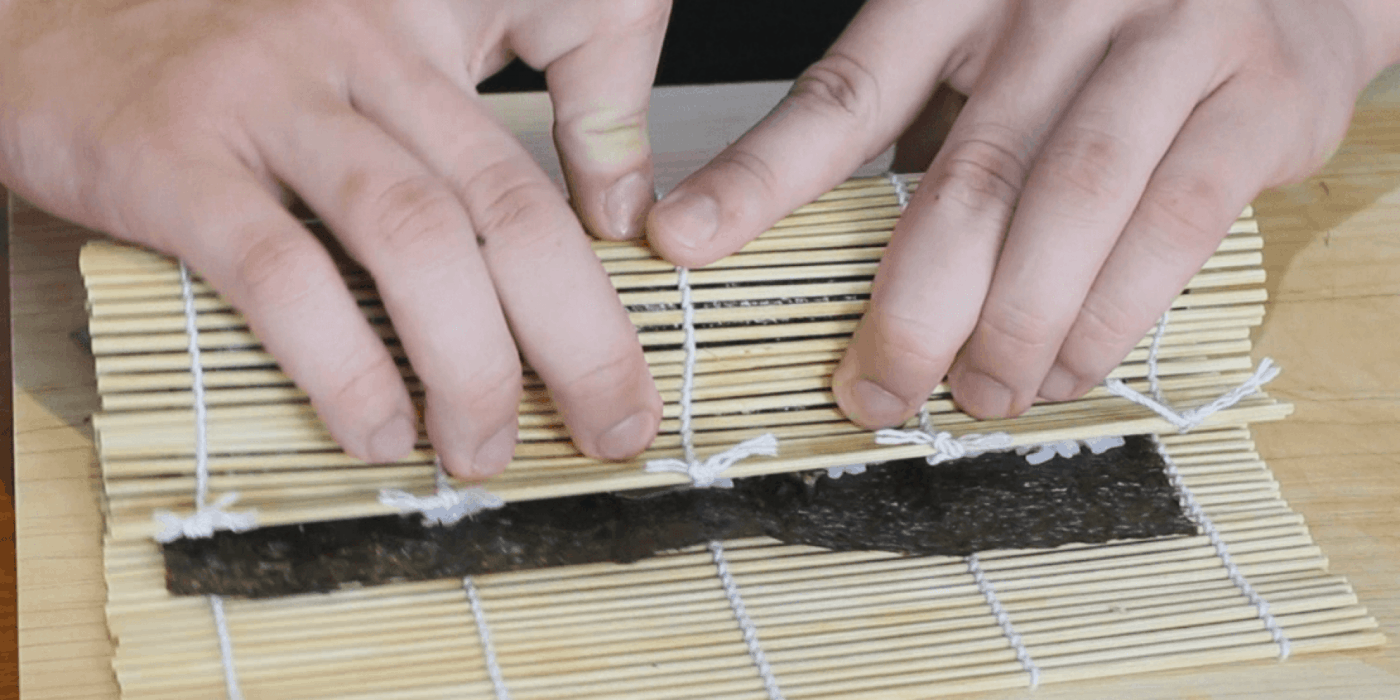
- After rolling, you squeeze the sushi evenly, then roll it over a plate of fried dough. Next, roll the sushi roll over a plate of bread crumbs.
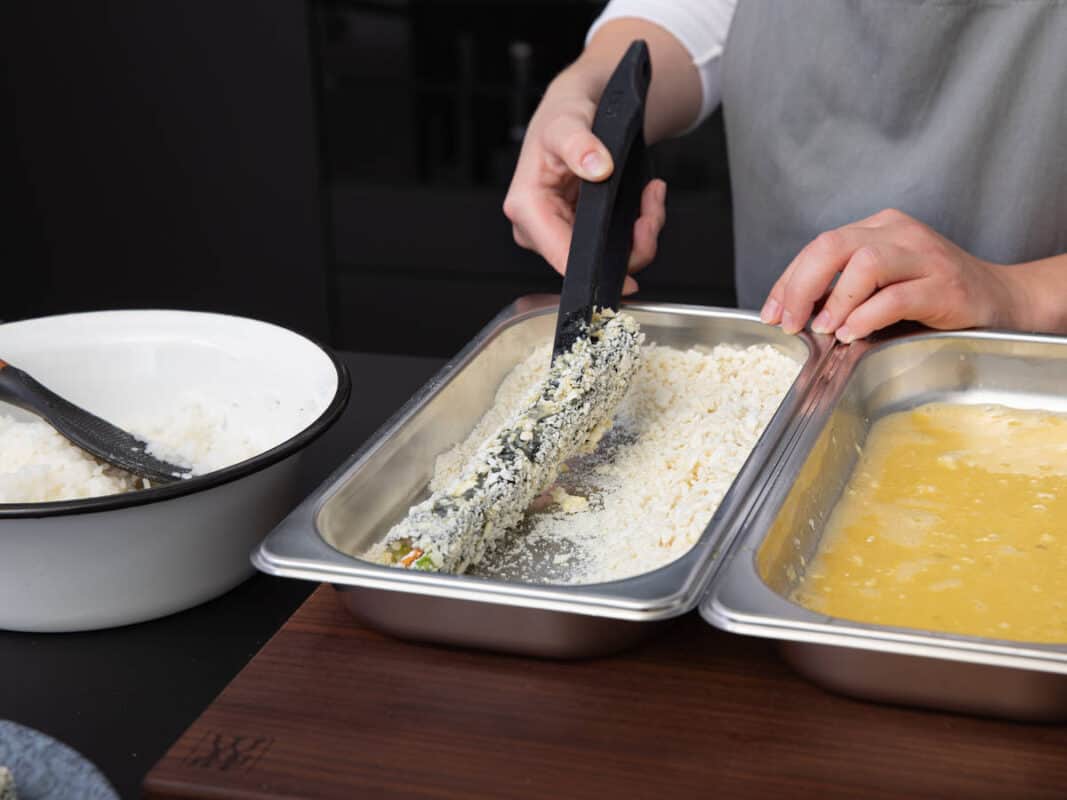
- Use the best skillets for glass top stoves, add about 4 tablespoons of oil (or add more oil to cover the sushi roll) heat. Gently drop the sushi roll and fry it until it’s golden crispy, cooked evenly. About 3-4 minutes later, gently roll the sushi roll to cook the sides evenly. About 4 minutes, take the sushi out of the plate lined under the oil absorbent paper.
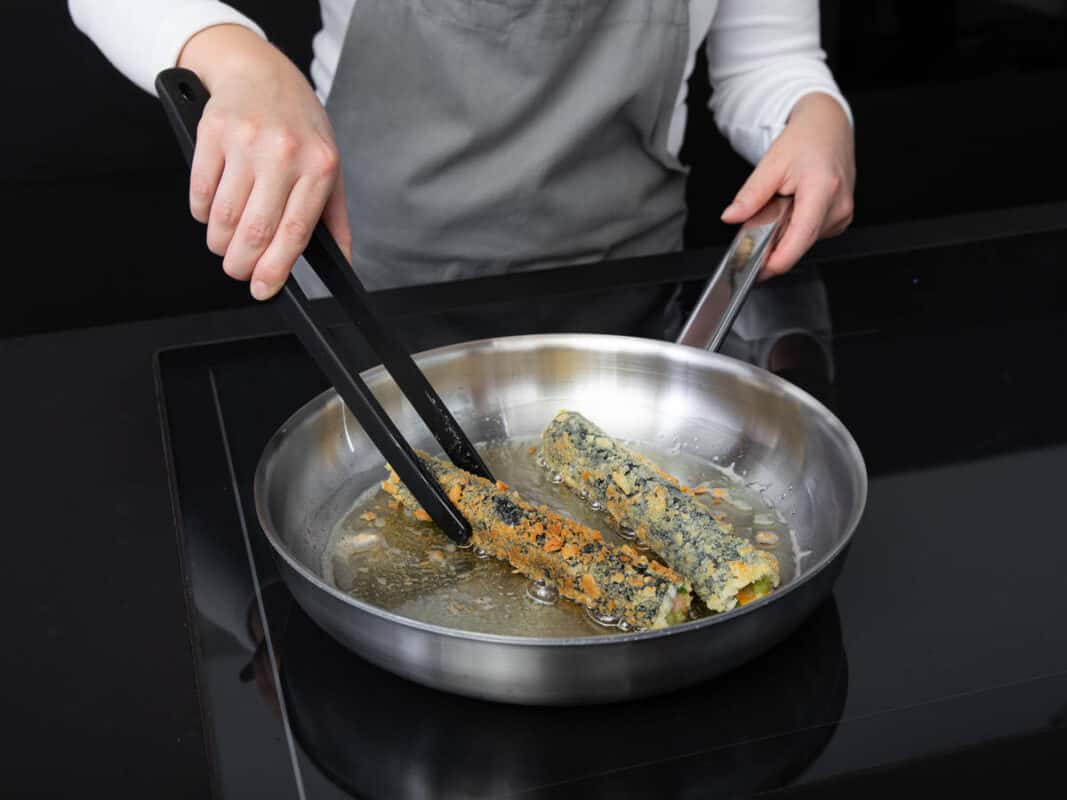
- Wait for the sushi roll to cool down, cut it into circles. This fragrant crispy sushi with a cup of hot chili sauce is delicious!
No products found.
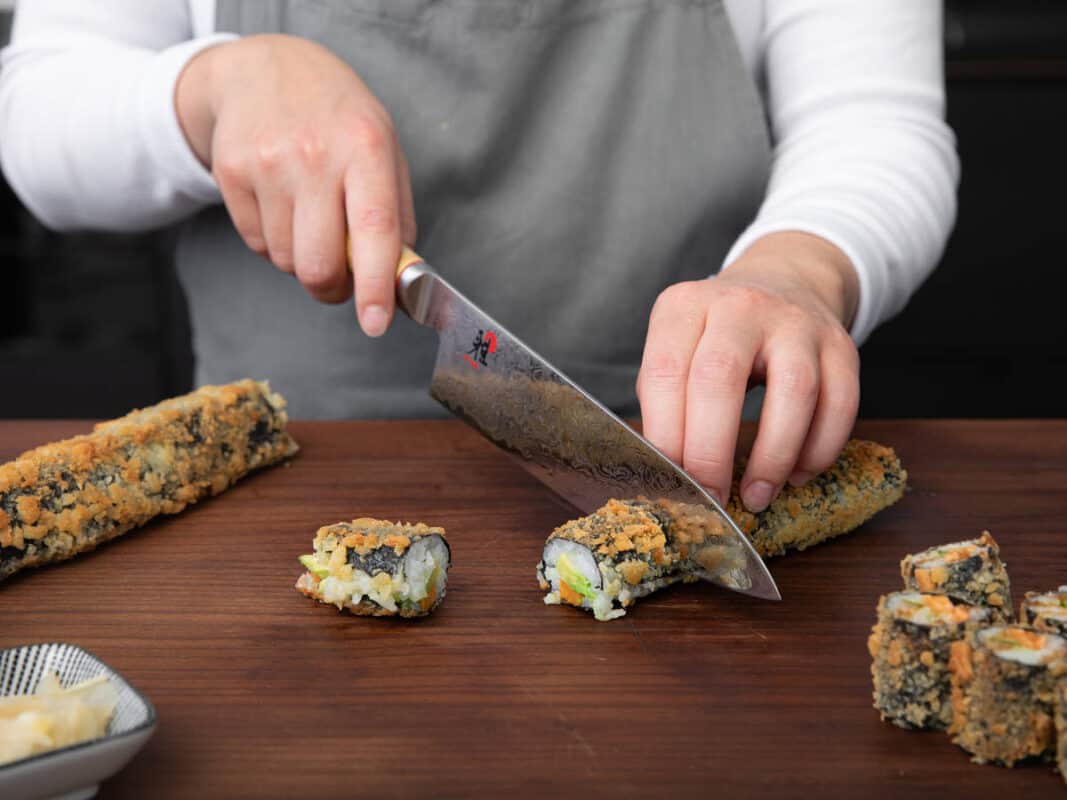
- Nigiri Sushi shrimp sushi
Material
Nigiri is a type of sushi that consists of a slice of raw fish as a topping on a rice roll mixed with vinegar. In addition, boiled shrimp is also a popular topping ingredient to make this sushi. The ingredients you need to prepare only include:
- 150 grams of sushi rice (cooked, mixed with a sugar vinegar mixture similar to the above recipes)
- 4 tablespoon Hondashi
- Fresh shrimp tail: 8 pcs (about 30 grams)
- 3 teaspoons of rice vinegar, on a plate
- 2 teaspoons of wasabi
- Dip your hands in a cup of clean water to moisten.
- Put the shrimp in a pot of diluted salt water to boil to boil. About 2-3 minutes later, take out the shrimp, soak the ice for hunting, then take out the basket to drain.
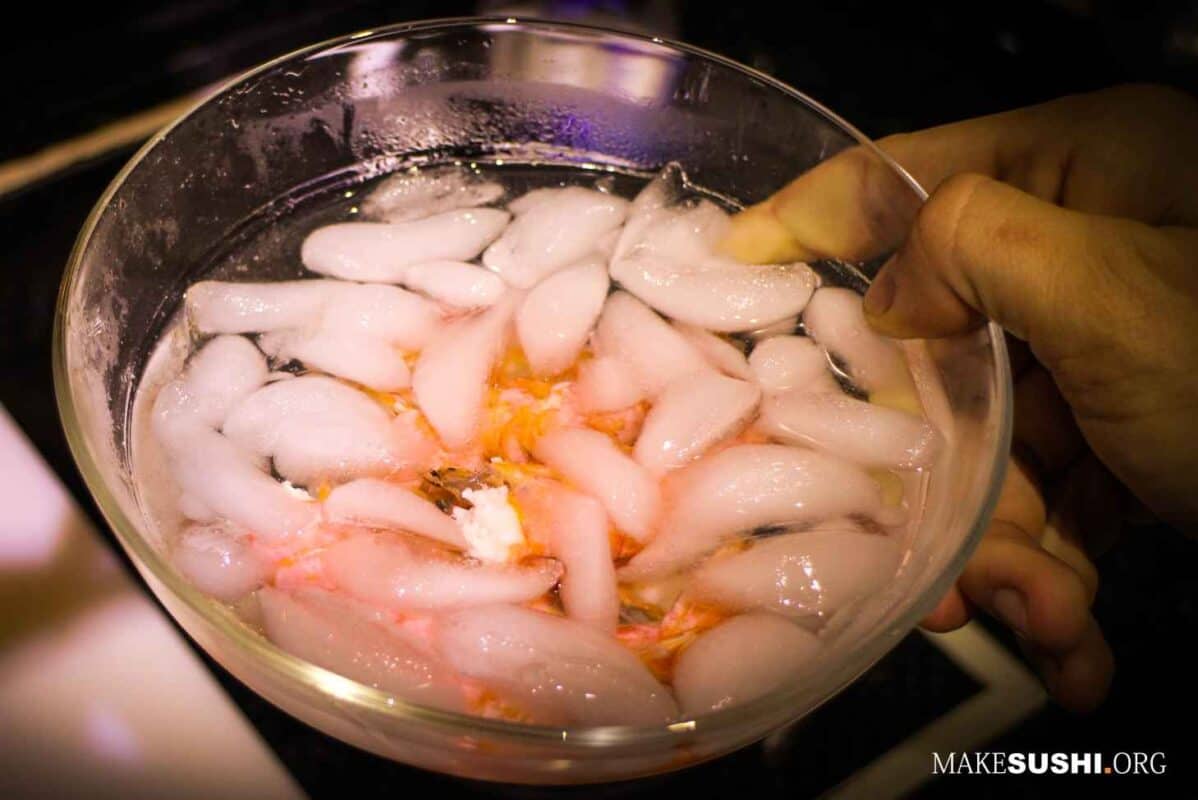
- Use a knife to cut the tail of the shrimp so that it splits into a butterfly, then dip it into a plate of vinegar for 3 minutes. After this time, take the shrimp out and gently sprinkle the vinegar.
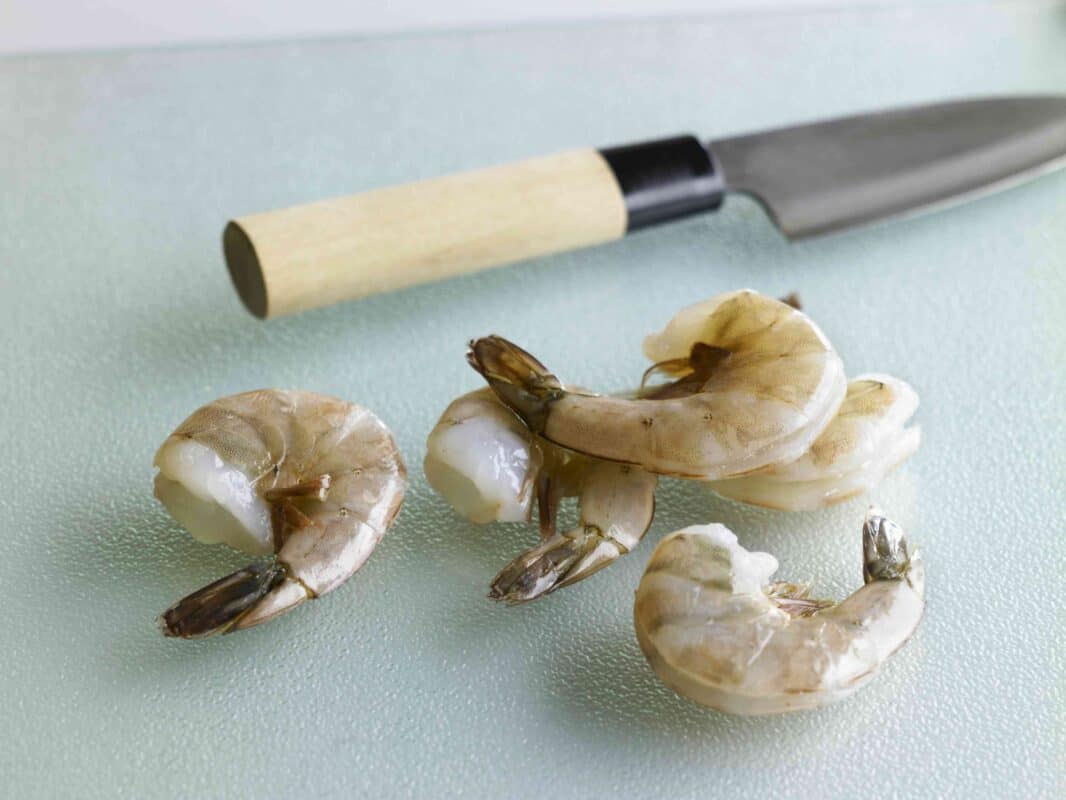
- Take the sushi rice into small rectangular blocks.
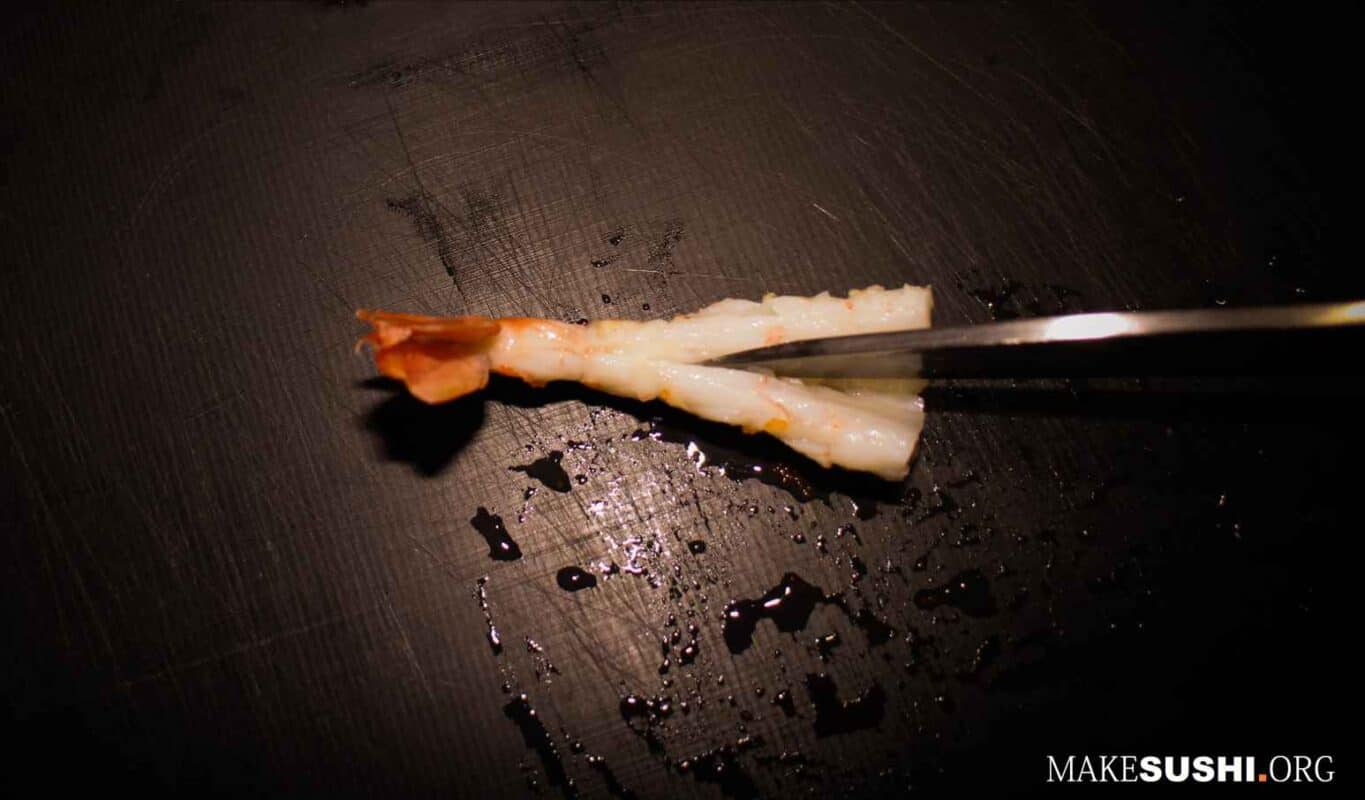
- Take a little wasabi and dot the inside of the tail, then press lightly on the sushi rice. Done until all the shrimp and rice are ready to enjoy.
- Miso Soup
Material
- 1 1/2 quarts of water
- 4 tablespoon Hondashi
- 1/2 ounce of pretty grated flakes
- 6 tablespoons of miso paste or a combination of white or red
- Silk tofu with 8 ounces solid, sliced into 1/2 inch cubes
- Dry wakame algae 1/2 ounce (1/4 cup)
- 4 ounces of fresh mushrooms, if possible sliced
- A few little live cockles
- 4 full scallions, thinly cut
- You wonder how to use hondashi on this step? In a large cup, mix the water, kombu with bonito flakes, 4 tablespoons Hondashi and simmer over medium temperature. Decrease to a bare cooker for five min. Remove from the sun, let it cool, after which strain via a thin mesh strainer for five minutes. Reject solids.
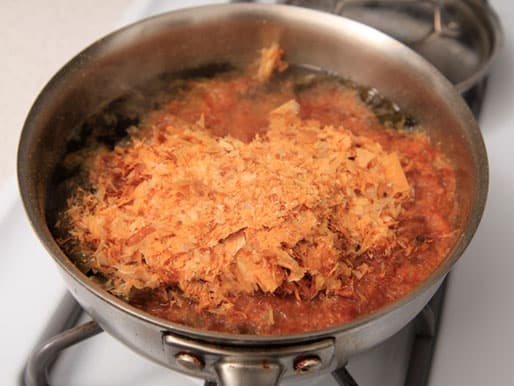
- Transfer broth to a small cup and set it to steam, but not steam over low heat. Put in the broth a thin mesh strainer and apply the miso paste. Using a spoon’s back to push the paste into the soup, discard, then large grains which are not moved over.
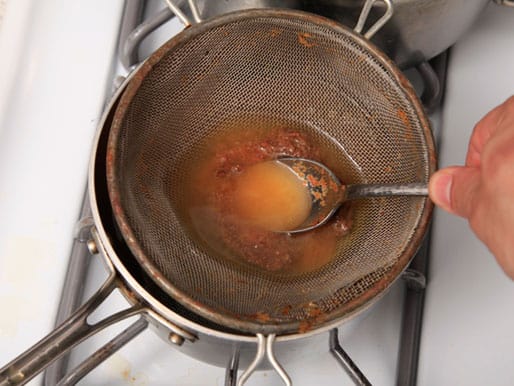
- Add tofu, wakam, champagne and cockles, if used, and let cook without boiling, about five minutes, until the components are warm with wakama and have renewed hydration. Add scallions (if used) & serve immediately.
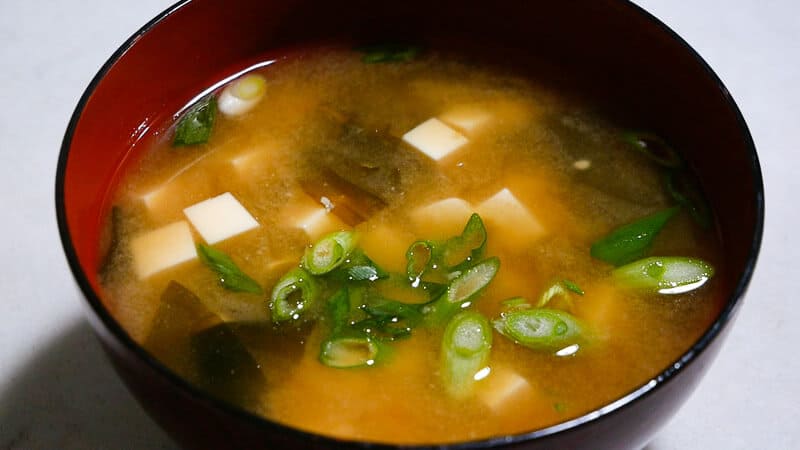
- Okonomiyaki
Okonomi means “as you like it,” and the okonomiyaki are among the most endlessly adaptable dishes in the world. The ripped or cut chab in the foundation is a certain thing, but afterwards, you can apply whatever you want to the hitter. Once you have some japanese staples throughout your shop (all of them have a permanent shelf life), make it inexpensive, quick, simple, and filling at home. Most of all, that’s nice to use remains.
Materials
1/2 tiny chop, finely shredded
5 tablespoon Hondashi
3 thinly cut, dark green pieces separately allocated
Beni-shoga 2 ounces (50g)
Katsuobushi 1/2 ounce (15g), split
Two big eggs
1/4 pound yamaimo, scraped and grated to the smallest box grater holes
120ml of cold or dashi water
3/4 cup meal (3/4 oz; 110g) for all purposes.
Unripe pork belly 8–10 thin pieces
2 cucumbers (30ml) of vegetable oil
Ao-nori, sauce okonomiyaki & mayonnaise Kewpie, to be served
- Mix in a wide bowl col, spring onion whites & half greens, quarter beni-shoga, yamaimo, eggs, 3/4 katsuobushi into dashi. Sprinkle beef. Remove with a bend and pound heavily until there is a dense batter and plenty of shapes.
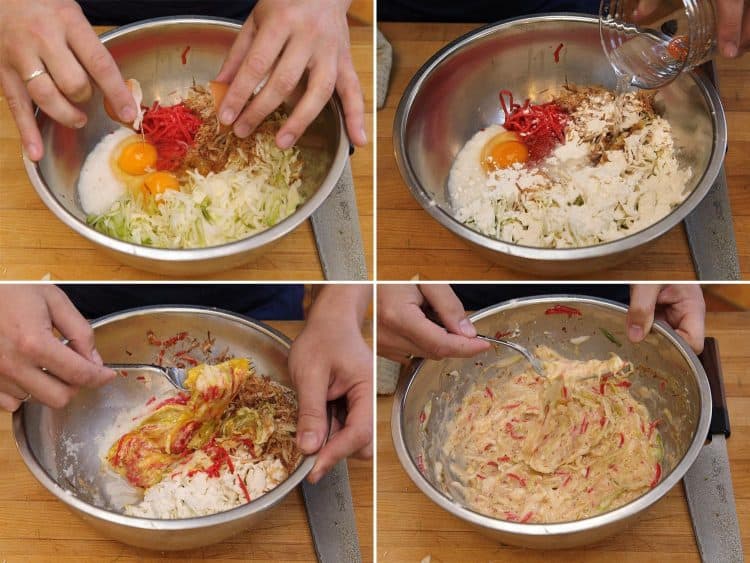
- While cooking pork belly, water in the bottom with both a 10″ non-stick pot to pork belly as well as position over medium high heat. Add okonomiyaki and scatter with a fork into an even sheet. If pork belly is not used, heat the olive oil in the pot over medium warmth until it shimmers. Add okonomiyaki and scatter with a fork into an even sheet.

- Take a pan regularly, cover and cook until the bottom layer becomes crisp and also well browned, around 10 minutes, and reduce the heat if the col is starting to burn.
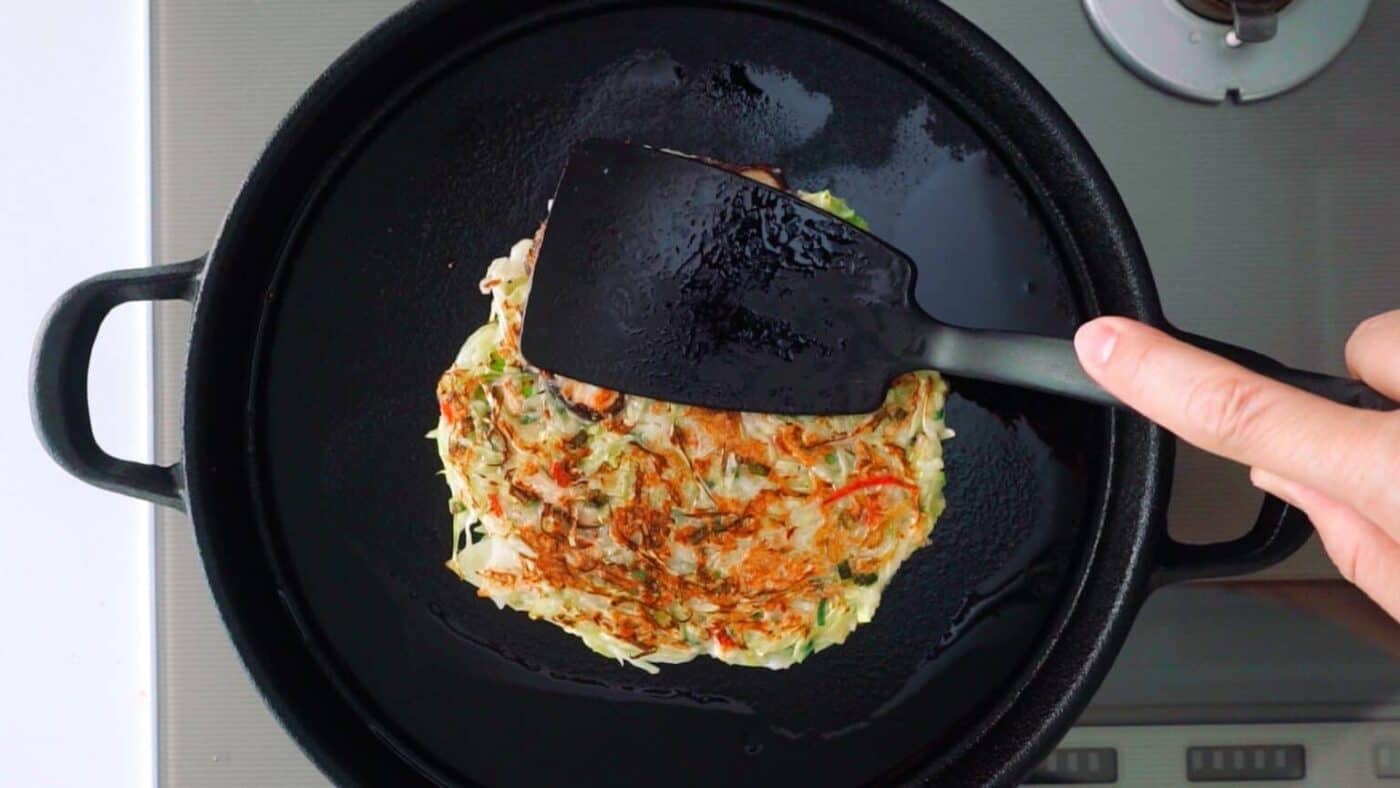
- Drain all extra fat and then work on a sink and keep the lid against a pot-holder firmly, tilt the whole pan and the lid over to move okonomiyaki to a pan. Remove the pot and then glide the okonomiyaki gently out of the cover then back into the pot.
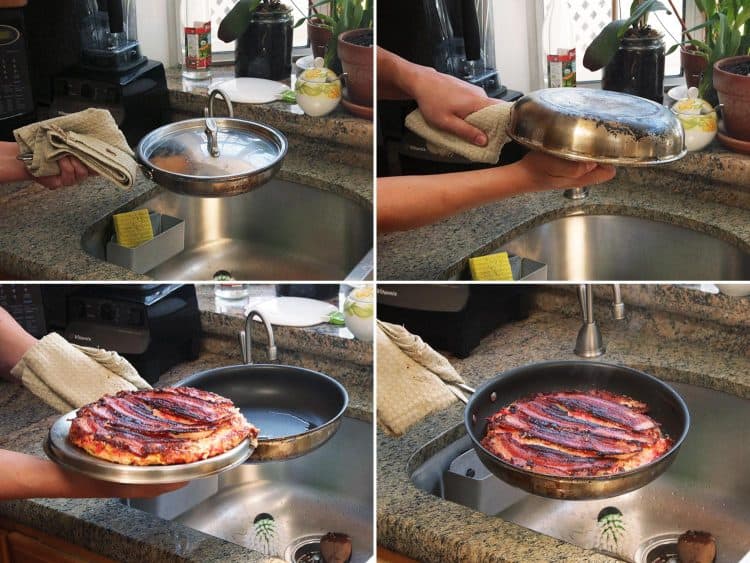
- Back to the flame, cover and cook till both sides look brownish and okonomiyaki becomes custardy and tender in the middle about eight minutes longer. Switch to a dish, pork flat side.
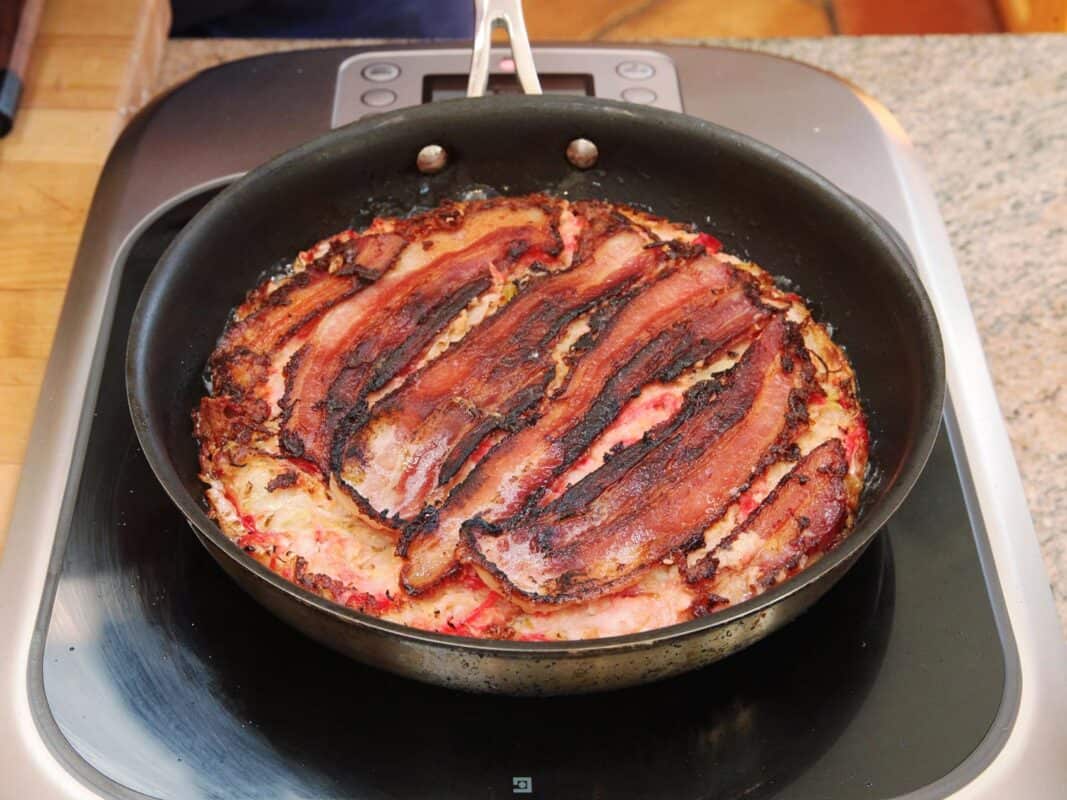
- Spray with ao-nori, the rest of beni-shoga, the rest of katsuobushi, as well as other scallion greens and serve directly off a shared dish.
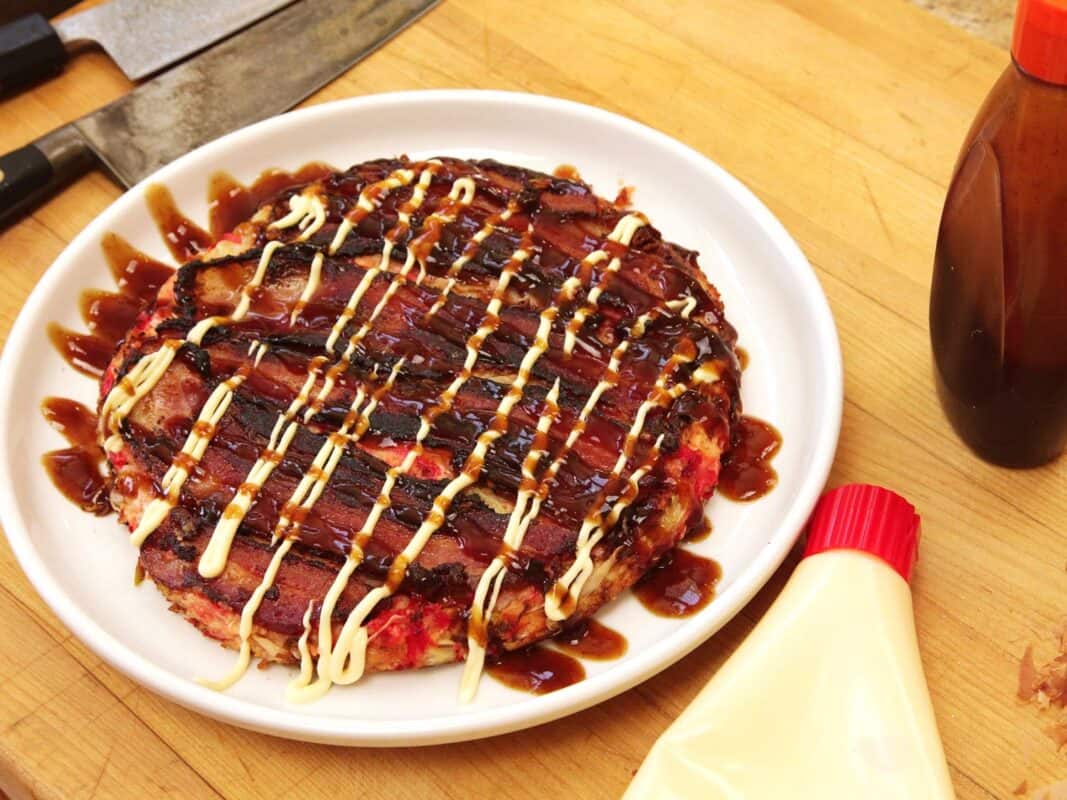
Tip For Recipe To Make Homemade Seaweed Hondashi – Fish Flakes
With only 3 simple steps below, you can make your own homemade Hondashi marine fish flakes flavored dough and taste delicious food!

You need to prepare the following ingredients to make Hondashi:
– 15g dry Kombu algae
– 30g dried shaved fish
– 2 small teaspoons ground pepper
– 10g of fine ground salt
– 30g palm sugar powder
(The ingredients can reduce salt and sugar to suit your taste. Do not increase the amount of algae and fish so that the broth is clear and fragrant when seasoning.)
- Cut algae leaves into small strands, remember not to wash the algae leaves
- Lightly roast the algae fibers on low heat. When algae turn pale green, squeeze it crispy, then turn off the heat. Avoiding it too long will lose the algae nutrients.
- Compare the color of the original dried algae leaves and the algae fibers after preliminary roasting.
- Wait for the algae to cool, you add the fish flakes, sugar and salt to the grind.
- Note: Algae is a bit difficult to grind, so you should patiently grind for a little while.
- Then mix in pepper. Put in the bottle, store in a cool place.
- The finished Hondashi is dry, smooth, fragrant and light yellow in color. This seasoning powder can be stored for 2 weeks.
Kombu seaweed is very healthy. So now you can figure out how to use Hondashi for cooking. When cooked, it releases glutamic acid – a sweetener and an amino acid important for brain development and body growth. At the same time, algae also provides a lot of fiber, iron, calcium and iodine, so when adding to the ingredient of seasoning powder, daily use is very suitable not only for adults but also for children. Especially non-fishy algae, often used by Japanese mothers to cook Dashi water for babies to eat. These will be a great source of minerals and natural iodine that any mother wants her baby to get.
No products found.
Q&A Part
How to preserve Hondashi?
You need to store in a cool dry place, away from direct sunlight. No refrigeration is required and used for 6 months after opening.
Where can I buy HonDashi?
HonDashi is also a fast way of making dashi stock at local grocery stores on the Asian avenue or from internet specialty stores. In general, approximately 1 spoon can be used for 1 to 3 glasses of water. Follow the packaging guidelines for the exact proportions as they can differ according to brand. Taste before applying more HonDashi if in doubt.
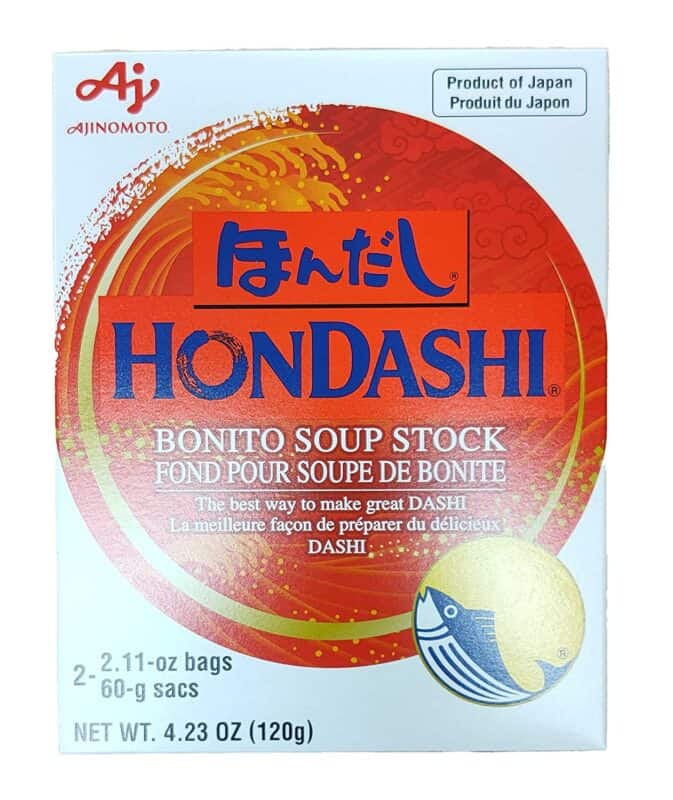
Is there any mystery of Hondashi for sushi?
You can season with 1 teaspoon of Hondashi while you are whisking the eggs
It is recommended to use wooden bowls instead of metal bowls to avoid causing reactions that affect the taste of food.
Sushi rice should be stored at room temperature.
Using the best skillets for glass top stoves to perfectly fry the eggs without crumbling.
You should wrap the rice with a damp cloth to prevent it from drying out.
You can also use a fan when performing step 4. This will help the rice cool down more quickly.
How many types of Dashi?
Iriko: made of dried baby sardines or anchovies
Kombu: vegan, created of kelp
Shiitake: vegan, often made with mushrooms of shiitake
Awase: made of kelp and beautiful
Katsuo: composed of flakes of shaved tuna
Hondashi is going to go bad?
It’s dry and also has lots of salt, which ensures the bacteria can grow really strong. If it gets clumping up even if it feels horrible, it won’t be healthy, but it’s okay for a long period of time otherwise.
Closing thought
In Japanese cuisine, hondashi plays an essential role as a taste enhancer so you don’t have to flavor the food with plenty of salt, fat and sugar. Wealthy in minerals as well as other nutrients, hondashi are regarded in our balanced meals as a good ingredient.
No products found.
This method is a great example of how to use hondashi as a kind of cached flavor that can add its savoriness to a dish’s more open aromas. It is also one of several cases where hondashi will be more valuable than an instant made of kombu & katsuobushi, since it is so thin. In this regard, it is an excellent starting point to find out about how to add tiny amounts of dashi, like the way you use fish sauce to improve the savory flavor of sauce or chili verde.
| Read Also: Top 19 Best Bread Machine Consumer Reports: Enjoy Fresh Bread Everyday Top 10 Best Gauge For Kitchen Sink: Which One Should You Choose? |
G Patel has been honing his craft in the restaurant industry for over 25 years. After graduating from North Carolina State University with a degree in business, G set out to turn Eschelon Hospitality into a recognized brand throughout Carolina’s state restaurants; and he did just that when acquiring Mura North Hills. Since then, it has become an iconic sushi-serving establishment.

